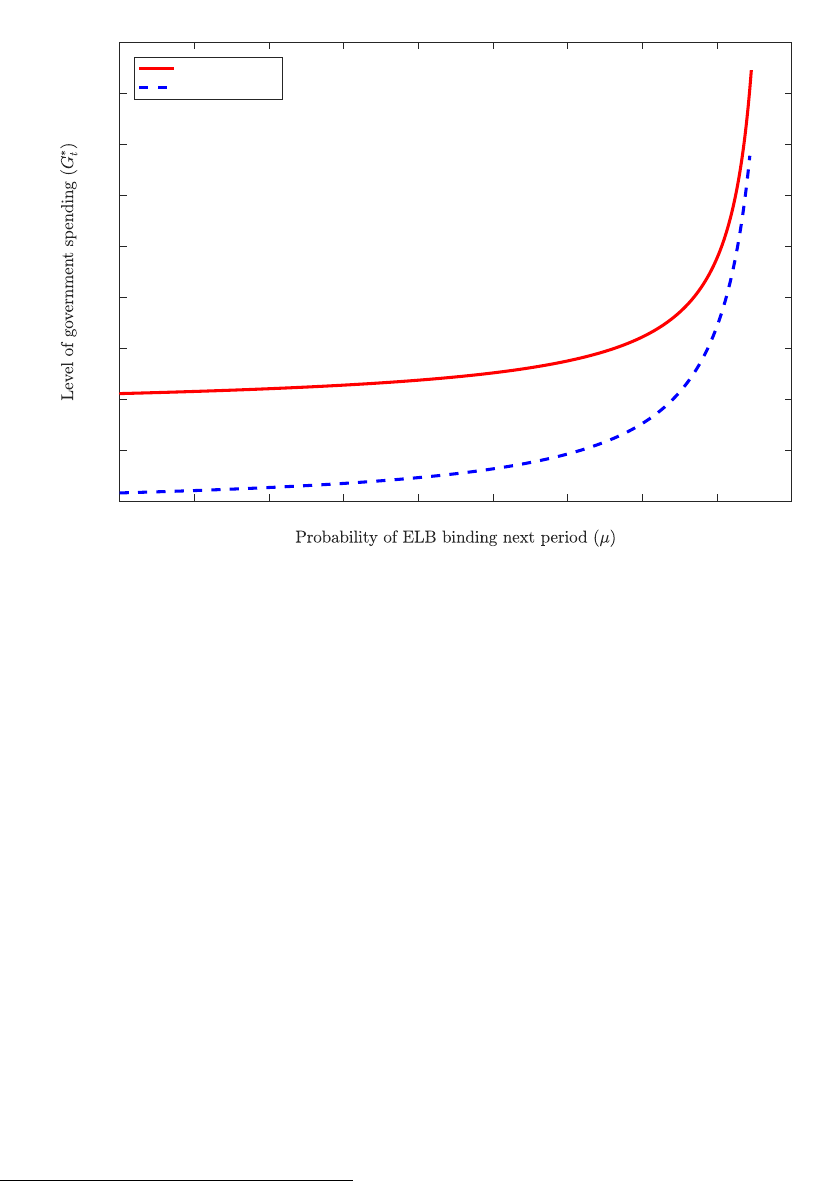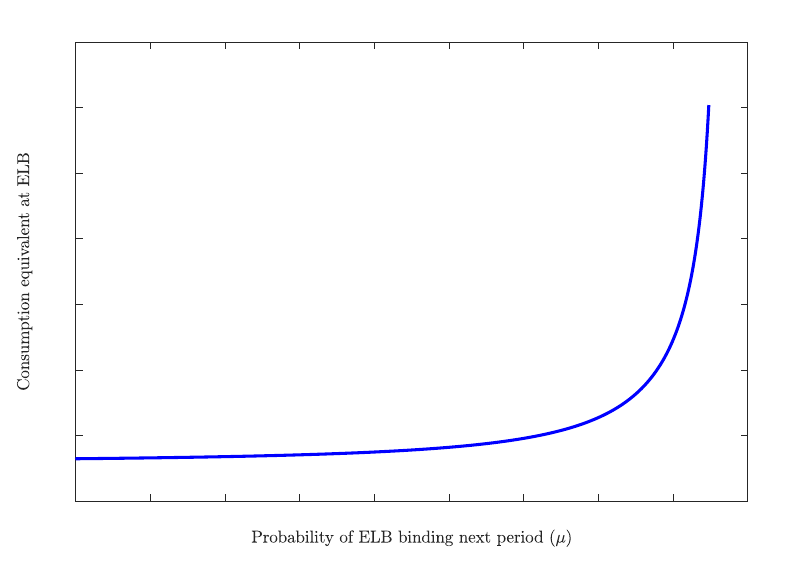
Fiscal policy coordination in currency unions
at the effective lower bound
Thomas Hettig and Gernot J. M¨uller
∗
January 2017
Abstract
According to the pre-crises consensus there are separate domains for monetary and fiscal
stabilization in a currency union. While the common monetary policy takes care of union-
wide fluctuations, fiscal policies should be tailored to meet country-specific conditions.
This separation is no longer optimal, however, if monetary policy is constrained by an
effective lower bound on interest rates. Specifically, we show that in this case there are
benefits from coordinating fiscal policies across countries. By coordinating on a common
fiscal stance, policy makers are able to stabilize union-wide activity and inflation while
avoiding detrimental movements of a country’s terms of trade.
Keywords: Currency union, fiscal policy, effective lower bound, coordination,
EMU, terms-of-trade externality, optimal policy
JEL-Codes: E61, E62, F41
∗
Hettig: Bonn Graduate School of Economics and University of T¨ubingen; Email: thomas.hettig@uni-
tuebingen.de; M¨uller: University of T¨ubingen, CESifo and CEPR, London; Email: gernot.mueller@uni-
tuebingen.de. We thank Yao Chen, Cyntia Freitas Azevedo, Fabio Ghironi, Martin Hellwig, Keith Kuester,
Klaus Prettner, Joost R¨ottger, Alexander Scheer, Martin Wolf, and participants in various seminars and con-
ferences for helpful comments and discussions. Part of this research was conducted while Hettig visited the
Brazilian Central Bank in Bras´ılia and he would like to thank the research department for its hospitality. We
also gratefully acknowledge financial support by the German Science Foundation (DFG) under the Priority
Program 1578. The usual disclaimer applies.

1 Introduction
In the wake of the global financial crisis, fiscal policy staged a comeback as a stabilization tool.
Figure 1 displays two rough measures of the discretionary fiscal stance, both for the US and
the euro area. The left panel shows the change of the cyclically adjusted government budget
deficit, measured in percentage-point changes relative to the pre-crisis year 2007. The right
panel shows the level of government consumption relative to trend output. Both measures
are indicative of an expansionary fiscal stance during the recession: deficits rose sharply after
2007, as did government spending. It appears, however, that fiscal stabilization has been used
more timidly in the euro area: not only did deficits increase less than in the US, government
spending was also raised relatively less, given its higher pre-crisis level.
One possible explanation is that euro-area fiscal policy is largely determined at the country
level, rather than at the union level and, hence, there may have been a failure to coordinate
fiscal stabilization across the member states of the euro area.
1
In line with this conjecture,
there have been calls for stronger policy coordination, urging European governments to en-
gineer a larger fiscal expansion during 2008–09 (see, for instance, Krugman, 2008). For the
same reason, the shift to austerity in the euro area after 2010 may have been excessive, as
argued by many observers (see, for instance, Cotarelli, 2012). Against this background, we
ask whether fiscal-stabilization policies should be coordinated across the member states of a
currency union with a view towards stabilizing area-wide activity and inflation.
According to the pre-crises consensus fiscal stabilization should be geared towards country-
specific conditions, because the common monetary policy can take care of union-wide fluctu-
ations (Beetsma and Jensen, 2005; Kirsanova et al., 2007; Gal´ı and Monacelli, 2008).
2
The
recent economic and financial crises have exposed a shortcoming of this paradigm: in a se-
vere economic downturn monetary policy may be constrained by an effective lower bound
(ELB) on nominal interest rates and thus be unable to stabilize fluctuations at the union
level. Moreover, it is precisely under these circumstances that fiscal policy is very effective in
stabilizing economic activity (Christiano et al., 2011; Woodford, 2011).
In our analysis we therefore explicitly account for the possibility that an ELB constrains
1
To be sure, there has been an attempt to coordinate European fiscal stabilization policies, namely through
the European Economic Recovery Plan, discussed and legislated in 2008–09. According to Cwik and Wieland
(2011) the measures foreseen by the plan amounted to 1.04 and 0.86 percent of 2009 and 2010 GDP, respectively.
Hence, they were considerably smaller than those due to US legislation under the American Recovery and
Reinvestment Act which amounted to roughly 5 percent of GDP.
2
Earlier contributions also allow for the possibility that the objectives of monetary and fiscal policy differ.
This does not necessarily strengthen the case for coordination (Dixit and Lambertini, 2003). In fact, fiscal
coordination may even be harmful (Beetsma and Bovenberg, 1998). Dixit and Lambertini (2001) offer some
qualifications as well as further references. Schmidt (2013) studies coordinated monetary and fiscal stabilization
in a closed economy when an effective bound on interest rates binds.
1

2007 2008 2009 2010 2011 2012 2013 2014
-2
0
2
4
6
Budget deficit
US
EA
1995 2000 2005 2010
0.14
0.16
0.18
0.2
0.22
Government consumption
Figure 1: Euro area (EA): solid lines, United Staates (US): dashed lines; left panel: cyclically
adjusted deficit, annual observations, change relative to 2007, measured in percentage points
of potential output; right panel: government consumption of general government in units of
trend output, quarterly observations; source: OECD Economic Outlook.
monetary policy. We do so within the framework of Gal´ı and Monacelli (2008). It specifies
a currency union which consists of a continuum of small open economies, each negligible in
terms of aggregate outcomes. Yet as countries specialize in the production of a specific set of
goods, domestic policies—if enacted unilaterally—will generally impact a country’s terms of
trade. In the absence of policy coordination, the optimal policy will therefore be conducted
with a view towards its effect on the terms of trade. Instead, by coordinating on a common
policy, countries can internalize this “terms-of-trade externality”.
3
Hence, optimal policies
will generally differ depending on whether there is coordination across countries or not.
In terms of country-specific policies, we focus on government spending. We assume that
the government purchases only domestically produced goods, financed by lump-sum taxes
levied on domestic households. We consider a representative household in each country which
supplies labor and trades a complete set of state-contingent assets across countries. Its con-
sumption basket includes goods produced in all countries of the union, but is biased towards
domestically produced goods. Goods, in turn, are produced in a monopolistic competitive
environment and firms are restricted in their ability to adjust prices. In “normal” (or pre-
crisis) times monetary policy is able to perfectly stabilize inflation and output at the union
level: there is no need for fiscal coordination across countries. We contrast this situation
with a “crisis scenario” where monetary policy is unable to lower interest rates sufficiently in
3
See Corsetti and Pesenti (2001), Benigno and Benigno (2003), De Paoli (2009) and Forlati (2015) for
different perspectives on the terms-of-trade externality in the context of monetary policy.
2

response to a union-wide contractionary shock, because it is constrained by an ELB.
4
We determine the optimal discretionary adjustment of government spending in the crisis
scenario. Under coordination fiscal policies are set to maximize union-wide welfare. In the
absence of coordination fiscal policy makers maximize country-specific welfare. We find that—
in line with the conjecture above—countries provide too little stimulus at the ELB in the
absence of coordination. Intuitively, local policymakers are keen to avoid the terms of trade
appreciating too much with higher spending, as this lowers the demand for domestically
produced goods at times of economic slack. Conversely, the increase of government spending
is higher under coordination, because policy makers anticipate that the terms of trade remain
unaffected by a policy response which is common across countries. At the same time, such a
response is expected to boost union-wide inflation (rather than an individual country’s terms
of trade). This is desirable at the ELB, because expected inflation lowers the real interest rate.
We illustrate that the fiscal stimulus gap due to the lack of coordination can be quantitatively
significant.
Within our framework we recoup two results which have already been established in the
literature, but are crucial to put our main result into perspective. First, we confirm an
earlier finding of Turnovsky (1988) and Devereux (1991): absent cooperation policy makers
choose too high a level of government spending in steady state. This is because governments
seek to improve their country’s terms of trade through purchases of domestically produced
goods.
5
Hence, in steady state the terms-of-trade externality has the opposite effect than
in the crisis scenario, because stronger terms of trade are beneficial in the long run, as the
economy operates at full capacity.
Second, we also contrast government spending multipliers, that is, the percentage change
of domestic output given a (possibly non-optimal) increase of government spending by one
percent of GDP in the entire union and in the domestic economy only. In line with earlier
work by Fahri and Werning (2016), we find that the multiplier is larger than unity in the
first case, provided the ELB binds, but smaller than unity in the second case.
6
This result
4
We abstract from non-conventional policies such as forward guidance (Eggertsson and Woodford, 2003)
or credit policies by the central bank (see, e.g., C´urdia and Woodford, 2011). These policies are arguably an
imperfect substitute for conventional policies, if only because they are not very well understood and hence
controversial (see, e.g., Rogoff, 2016). The effectiveness of forward guidance, in particular, appears to be
limited (Giannoni et al., 2016).
5
Epifani and Gancia (2009) find that this mechanism may account for the size of the public sector in open
economies. In particular, their findings suggest that the terms-of-trade externality rather than a demand for
insurance causes the public sector to grow with trade openness.
6
Erceg and Lind´e (2012) also compute spending multipliers for a small open economy. Assuming an exchange
rate peg, they show that multipliers are always below unity. Assuming a specific scenario under which the
ELB binds, they find that for multipliers to exceed unity prices need to be sufficiently flexible. Nakamura
and Steinsson (2014), in turn, show that multipliers are high within a currency union when compared to the
multiplier at the union level in the absence of a binding ELB constraint. Acconcia et al. (2014) find for Italian
3

obtains because a unilateral increase of government spending appreciates the terms of trade
and thus crowds out private expenditure. Instead, the cooperative policy, common to all
countries, raises expected inflation at the union level, thus crowding-in private expenditure
at the ELB.
7
Our analysis also relates to a number of other recent studies. Cook and Devereux (2011)
study optimal fiscal policy in a two-country model when monetary policy is stuck at the
ELB. However, they focus on the case of coordination, rather than on a possible coordination
failure. Blanchard et al. (2016) calibrate a two-country model to capture key features of
the euro area, notably of its core and periphery. They share our focus on the gains from
cooperation. However, because their model is more complex than ours, their analysis is limited
to numerical evaluations of an ad-hoc welfare criterion. Evers (2015) studies the performance
of alternative fiscal arrangements in a quantitative model of a currency union. He finds that
a centralized fiscal authority dominates a regime of fiscal transfers as well as a regime of
decentralized fiscal decision making. Other work has focused on the coordination of debt and
deficit policies in currency unions (Beetsma and Uhlig, 1999; Krogstrup and Wyplosz, 2010).
We abstract from this aspect, as Ricardian equivalence obtains in our model. Moreover, we
stress that our analysis disregards complications due to sovereign risk. However, both aspects
are likely to further strengthen the case for coordination in currency unions stuck at the ELB
(Corsetti et al., 2014).
The remainder of the paper is structured as follows. In Section 2 we describe the basic
setup of the model. It also contrasts government spending multipliers at the union and the
country level, once the ELB binds. In Section 3 we analyze the need for coordination by
determining optimal government spending with and without coordination. Section 4 provides
a quantitative assessment. Section 5 concludes.
2 Model
Our analysis is based on the model of Gal´ı and Monacelli (2008). There is a currency union
which consists of a continuum of countries, each a small open economy indexed by i ∈ [0, 1].
Each economy features a representative household, a continuum of monopolistically competi-
tive firms and a fiscal authority. Monetary policy is conducted at the union level. We consider
two dimensions which are absent in Gal´ı and Monacelli (2008). First, we allow for the possi-
data that variations in local government spending have fairly strong output effects.
7
An alternative perspective emphasizes monetary conditions: at the country level there is a de facto target
for the price level, given by purchasing power parity. Any inflationary impulse due to fiscal policy thus triggers
an offsetting deflationary tendency and causes the long term real interest rate to rise on impact (Corsetti et al.,
2013b). At the union level, absent a price level target, the inflationary impulse due to higher government
spending reduces real interest rates at the ELB.
4

bility that the ELB constrains monetary policy because of a union-wide contractionary shock.
Second, we compute optimal fiscal policies when there is no coordination across countries.
8
Our exposition focuses on the model structure in terms of preferences and technology. In a
second step, we state the linearized equilibrium conditions at the country and the union level.
Readers may consult Gal´ı and Monacelli (2008) for further details on the derivations.
2.1 Model structure
In what follows we briefly outline the problem of households, the fiscal authority, firms and
monetary policy.
Households
A representative household in country i has preferences over private consumption, C
i
t
, public
consumption, G
i
t
, and labor, N
i
t
, given by
U(C
i
t
, N
i
t
, G
i
t
) = (1 − χ) log C
i
t
+ χ log G
i
t
−
N
i
t
1+ϕ
1 + ϕ
,
where parameter χ ∈ (0, 1) determines the relative weights of private and public consumption.
ϕ > 0 is the inverse of the Frisch elasticity of labor supply. Private consumption is a composite
of domestically produced goods, C
i
i,t
, and imported goods, C
i
F,t
:
C
i
t
≡
C
i
i,t
1−α
C
i
F,t
α
(1 − α)
1−α
α
α
.
Parameter α ∈ (0, 1) measures the openness of the economy. Because country i has zero
weight in the union, α < 1 implies that there is home bias in consumption which accounts for
deviations from purchasing power parity in the short run. Domestically produced goods are
a CES basket of product varieties:
C
i
i,t
≡
Z
1
0
C
i,t
(j)
ε−1
ε
dj
ε
ε−1
, with ε > 1. (1)
Here C
i,t
(j) denotes consumption of variety j ∈ [0, 1] in country i. Parameter ε > 1 denotes
the elasticity of substitution between different varieties of goods produced within each country.
Imported goods, in turn, are defined as follows:
C
i
F,t
≡ exp
Z
1
0
c
i
f,t
df,
8
Forlati (2009) also analyzes optimal fiscal policy in the absence of coordination within the Gal´ı-Monacelli
model. Her focus is on the interaction of monetary and fiscal policy without considering an ELB.
5

with c
i
f,t
≡ log C
i
f,t
and f ∈ [0, 1]. The index C
i
f,t
is defined analogously to (1), with an
appropriate normalization.
9
Given the definitions above, minimizing expenditures gives rise to demand functions for prod-
uct varieties. For instance, domestic demand for generic good j is given by
C
i
i,t
(j) =
P
i
t
(j)
P
i
t
−ε
C
i
i,t
,
where P
i
t
(j) is the price of good j and P
i
t
≡
R
1
0
P
i
t
(j)
1−
dj
1
1−
is the domestic (producer)
price index. Similarly, country-i demand for a generic country-f good j is given by
C
i
f,t
(j) =
P
f
t
(j)
P
f
t
!
−ε
C
i
f,t
.
Here P
f
t
(j) and P
f
t
have the same interpretation as the domestic counterparts. The optimal
allocation between domestic and foreign goods requires
C
i
t
= (1 − α)
P
i
t
P
i
c,t
!
−1
C
i
t
, C
i
F,t
= α
P
∗
t
P
i
c,t
!
−1
C
i
t
,
where P
∗
t
≡ exp
R
1
0
p
f
t
df is the union-wide price index. The consumer price index (CPI) is
given by P
i
c,t
≡ (P
i
t
)
1−α
(P
∗
t
)
α
. In the following we focus on the producer price index, P
i
t
,
which is related to the CPI according to P
i
t
= P
i
c,t
(S
i
t
)
α
, where S
i
t
≡ P
∗
t
/P
i
t
denotes the terms
of trade.
Households trade a complete set of state-contingent securities which provides insurance against
country-specific shocks.
10
They maximize expected discounted lifetime utility subject to a
sequence of budget constraints:
max
{C
i
t
,N
i
t
,A
i
t
}
∞
t=0
E
0
∞
X
t=0
β
t
U(C
i
t
, N
i
t
, G
i
t
)
s.t. P
i
c,t
C
i
t
+ E
t
{Q
t,t+1
A
i
t+1
} ≤ A
i
t
+ W
i
t
N
i
t
+ P
i
t
− T
i
t
.
where A
i
t
denotes the portfolio of nominal assets and Q
t,t+1
is the nominal stochastic discount
factor (common across countries). Ponzi schemes are not permitted. W
i
t
is the nominal wage
and P
i
t
are firm profits, rebated to households in a lump-sum fashion. T
i
t
are lump-sum taxes.
Parameter β ∈ (0, 1) is the subjective discount factor.
9
See Gal´ı and Monacelli (2015). Without normalization either consumption of foreign goods or total
consumption goes to zero (Hellwig, 2015).
10
For instance, idiosyncratic technology shocks as in Gal´ı and Monacelli (2008). As we analyze optimal policy
in response to an aggregate shock that pushes the currency union at the ELB we abstract from country-specific
shocks in our analysis.
6

Fiscal authority
Public consumption is composed of domestically produced goods as in (1) and the fiscal
authority allocates expenditures in a cost minimizing manner. The resulting demand function
for a generic good j is given by:
G
i
t
(j) =
P
i
t
(j)
P
i
t
−ε
G
i
t
,
where G
i
t
is aggregate expenditure, the level of which remains to be determined below. Taxes
adjust to balance the budget in each period:
T
i
t
= P
i
t
G
i
t
+ τ
i
W
i
t
N
i
t
.
where τ
i
is a (constant) employment subsidy paid to domestic firms. If set appropriately it
ensures the efficiency of the steady state under monopolistic competition.
Firms
In each country, there is a continuum of monopolistically competitive firms, each of which
produces a differentiated good Y
i
t
(j). These goods are traded across countries and the law
of one price is assumed to hold. Firms cannot adjust their price P
i
t
(j) every period. Instead,
as in Calvo (1983) they may reset prices in a given period with probability 1 − θ, while their
current price remains in effect with probability θ ∈ (0, 1). The probability of resetting the
price is independent of a firm’s last adjustment. Firms hire labor N
i
t
(j) and produce with
a linear technology Y
i
t
(j) = N
i
t
(j) in order to satisfy the level of demand at a given price.
The objective of a generic firm j ∈ [0, 1] is to maximize discounted, expected nominal payoffs
taking the demand for its product into account:
max
¯
P
i
t
(j)
∞
X
k=0
θ
k
E
t
Q
t,t+k
Y
i
t+k
(j)(
¯
P
i
t
(j) − (1 − τ
i
)W
i
t+k
)
s.t. Y
i
t+k
(j) =
¯
P
i
t
(j)
P
i
t+k
!
−ε
Y
i
t+k
,
where
¯
P
i
t
(j) is the optimal price, set in period t.
Monetary policy
Monetary policy is conducted at the union level. The policy instrument is the nominal interest
rate, that is, the yield on a nominally riskless one-period discount bond: 1 + i
∗
t
≡
1
E
t
Q
t,t+1
.
The objective of monetary policy is to maintain price stability, that is, zero inflation at the
7

union level.
11
Importantly, monetary policy may be constrained by an ELB. Specifically, in
what follows we assume that i
∗
t
≥ 0, that is, we assume the effective lower bound to be zero.
While the actual lower bound is arguably somewhat below zero, this is of little consequence
in the context of our analysis. Below we specify an interest-rate rule which implements price
stability subject to the ELB constraint.
2.2 Equilibrium conditions for approximate model
We consider a log-linear approximation to the optimality and market-clearing conditions
around a symmetric, zero-inflation steady state. We use hats to denote log-deviations of a
variable from its steady-state value. For a generic variable X
t
we define x
t
≡ log X
t
and
ˆx = log(X
t
/X). Union-wide variables are obtained by integrating over all countries in the
union: ˆx
∗
t
=
R
1
0
ˆx
i
t
di.
First, goods-market clearing and integrating over all goods gives for country i
ˆy
i
t
= (1 − γ)(ˆc
i
t
+ αs
i
t
) + γˆg
i
t
. (2)
Parameter γ denotes the steady-state ratio of government consumption to output. The above
equation links domestic output ˆy
i
t
to domestic consumption ˆc
i
t
, the terms of trade s
i
t
and
domestic government spending ˆg
i
t
. Further, the assumption of complete markets gives rise to
the following risk sharing condition:
ˆc
i
t
= ˆc
∗
t
+ (1 − α)s
i
t
. (3)
Combining it with (2) gives
ˆy
i
t
= γˆg
i
t
+ (1 − γ)ˆc
∗
t
+ (1 − γ)s
i
t
. (4)
Equation (4) is an equilibrium condition at the country level which replaces the conventional
dynamic IS-equation (which still operates at the union level, see below). Integrating equation
(4) over all countries i ∈ [0, 1] and noting that
R
1
0
s
i
t
di = 0 leads to the union-wide market
clearing condition
ˆy
∗
t
= γˆg
∗
t
+ (1 − γ)ˆc
∗
t
. (5)
The second equilibrium condition at the country level accounts for the price-setting behavior
of firms and the law of motion for the price level. Specifically, we obtain the following variant
of the New Keynesian Phillips curve:
π
i
t
= βE
t
{π
i
t+1
} + λ
1
1 − γ
+ ϕ
ˆy
i
t
−
λγ
1 − γ
ˆg
i
t
, (6)
11
In the context of our model this is the optimal discretionary policy under fiscal coordination.
8

with λ ≡
(1−βθ)(1−θ)
θ
and where π
i
t
= p
i
t
− p
i
t−1
denotes the inflation rate. From the definition
of the terms of trade it follows that
π
i
t
= π
∗
t
− s
i
t
+ s
i
t−1
. (7)
Equations (4), (6) and (7) characterize the equilibrium in the small open economy given a
process for government spending and union-wide variables.
The union-wide equilibrium conditions are given by an aggregate Phillips curve:
π
∗
t
= βE
t
{π
∗
t+1
} + λ
1
1 − γ
+ ϕ
ˆy
∗
t
−
λγ
1 − γ
ˆg
∗
t
, (8)
which is obtained by integrating over the country-specific Phillips curves (6) and by a dynamic
IS curve:
ˆy
∗
t
= E
t
{ˆy
∗
t+1
} − (1 − γ)(i
∗
t
− E
t
{π
∗
t+1
} − r
t
) − γE
t
{ˆg
∗
t+1
} + γˆg
∗
t
(9)
with r
t
≡ − log β − ∆
t
. As in Woodford (2011), ∆
t
denotes a spread between the interest rate
set by the central bank and the one relevant for private sector decisions. It reflects frictions in
financial intermediation which we do not model explicitly, but permit to vary exogenously.
12
If this spread becomes large enough, monetary policy becomes constrained by the ELB. In
what follows, we thus assume that the conduct of monetary policy can be described by the
following rule
i
∗
t
= max {r
t
+ φ
π
π
∗
t
, 0} . (10)
By following this rule monetary policy fully stabilizes inflation and output at the union level
(as long as ˆg
∗
t
= 0), unless the ELB binds.
Effective-lower-bound scenario. In our analysis below, we consider a scenario where the
ELB binds because the interest rate spread increases temporarily. Specifically, as in Woodford
(2011), we assume a Markov structure for r
t
. It declines temporarily to a value r
L
< 0. The
shock remains operative with probability µ and is sufficiently large for the ELB to become
binding. Hence, (10) implies that i
∗
t
= 0 for as long as the shock lasts, independently on the
conduct of fiscal policy.
13
With probability 1 − µ the spread disappears (and thus the whole
economy) returns permanently to the steady state. Moreover, defining κ ≡ λ
1
1−γ
+ ϕ
,
we impose the parametric restriction (1 − µ)(1 − βµ) > (1 − γ)µκ for the equilibrium to be
uniquely determined (Woodford, 2011).
12
C´urdia and Woodford (2015) provide a microfoundation in a model which accounts for household hetero-
geneity and borrowing and lending across households.
13
Schmidt (2013) and Erceg and Lind´e (2014) consider endogenous exit from the ELB due to fiscal-policy
measures. We assume instead that the decline of r
t
is sufficiently large for the ELB to remain binding also in
the presence of optimal fiscal stabilization.
9

Definition of equilibrium. Given initial conditions (s
−1
) as well as {r
t
}
∞
t=0
an equilibrium
is a collection of
1. country-specific stochastic processes {ˆy
i
t
, π
i
t
, s
i
t
}
∞
t=0
for all i ∈ [0, 1]
2. union-wide stochastic processes {ˆy
∗
t
, π
∗
t
}
∞
t=0
with ˆy
∗
t
=
R
1
0
ˆy
i
t
di, π
∗
t
=
R
1
0
π
i
t
di
such that for given {ˆg
i
t
}
∞
t=0
for all i ∈ [0, 1] with ˆg
∗
t
=
R
1
0
ˆg
i
t
di and the path for the nominal
interest rate {i
∗
t
}
∞
t=0
determined by (10)
3. equilibrium conditions (4), (6) and (7) are satisfied for each country i and
4. equilibrium conditions (8) and (9) are satisfied on the union level.
For later purposes, we note that the equilibrium conditions imply the following second order
stochastic difference equation for the terms of trade (see Gal´ı and Monacelli, 2005)
s
i
t
= ωs
i
t−1
+ ωβE
t
{s
i
t+1
} − ωλϕγ(ˆg
i
t
− ˆg
∗
t
),
where ω ≡
1
1+β+λ[1+ϕ(1−γ)]
∈ [0,
1
1+β
). The above equation has a unique stable solution
s
i
t
= δs
i
t−1
+ δλϕγ
∞
X
k=0
(βδ)
k
E
t
{ˆg
∗
t+k
− ˆg
i
t+k
}, (11)
with δ ≡
1−
√
1−4βω
2
2ωβ
∈ (0, 1).
2.3 Impact multipliers: union-wide vs country-specific fiscal impulse
In this section, to set the stage for our main results in Section 3, we solve for the government
spending multiplier on output. That is, we determine by how much country-specific output
changes, given an increase of government consumption by one percent of output. Our focus is
on how the multiplier differs depending on whether there is a union-wide or a country-specific
variation of government consumption. As a union-wide fiscal impulse impacts the individual
countries symmetrically, this scenario is equivalent to the closed-economy setting in Woodford
(2011). Instead, a country-specific fiscal impulse impacts domestic output directly, but also
indirectly via the terms of trade. This scenario is thus equivalent to the small-open-economy
settings in Corsetti et al. (2013b) and Fahri and Werning (2016). We briefly revisit their
results within our framework.
Consider first the union-wide fiscal impulse in the ELB scenario. We assume that government
spending is increased in every country by the same amount as long as the ELB remains
binding. In this case, given the assumptions spelled out above, union-wide variables take a
10

constant value x
∗
L
, as long as the shock persists. In this case, the union-wide Phillips curve
and the IS equation simplify to
π
∗
L
=
1
1 − βµ
κ(ˆy
∗
L
−
¯σγ
¯σ + ϕ
ˆg
∗
L
), (12)
(1 − µ)(ˆy
∗
L
− γˆg
∗
L
) = (1 − γ)µπ
∗
L
+ (1 − γ)r
L
, (13)
with ¯σ ≡
1
1−γ
.
We solve the above system for ˆy
∗
L
as a function of r
L
and ˆg
∗
L
. This gives:
ˆy
∗
L
=
(1 − γ)(1 − βµ)
(1 − µ)(1 − βµ) − (1 − γ)µκ
r
L
+
(1 − µ)(1 − βµ)γ − (1 − γ)µκ
γ¯σ
¯σ+ϕ
(1 − µ)(1 − βµ) − (1 − γ)µκ
ˆg
∗
L
. (14)
In order to determine the multiplier, we divide the derivative of ˆy
∗
L
with respect to ˆg
∗
L
by the
steady-state share of government spending, γ:
1
γ
∂ˆy
∗
L
∂ˆg
∗
L
=
(1 − µ)(1 − βµ) − (1 − γ)µκ
¯σ
¯σ+ϕ
(1 − µ)(1 − βµ) − (1 − γ)µκ
≥ 1.
At the union level, we thus find that the multiplier is bound from below by unity (Woodford,
2011). Intuitively, higher government spending reduces real interest rates at the ELB, because
the expected inflationary impact of higher spending is not matched by higher nominal interest
rates. Hence, private-sector spending is crowded in.
We now turn to the effect of a country-specific fiscal impulse. In this case, for simplicity but
without loss of generality we set union-wide variables to zero and assume that government
spending in country i follows a two-state Markov switching process. Initially, government
spending exceeds its steady state level ˆg
i
L
> 0; it does so with probability µ in the next period
too and returns to steady state with probability 1 − µ.
Specifically, equations (4) and (11), evaluated in the impact period of the spending increase
read as follows
ˆy
i
1
= γˆg
i
L
− (1 − γ)p
i
1
p
i
1
=
δλϕγ
1 − βδµ
ˆg
i
L
.
Combining both equations, we obtain the government spending multiplier in the impact
period.
14
It is given by
1
γ
∂ˆy
i
1
∂ˆg
i
L
= 1 − (1 − γ)
δλϕ
1 − βδµ
| {z }
≥0
≤ 1.
14
Because a country-specific fiscal impulse impacts the terms of trade, the output effect of government
spending changes over time even though the size of the impulse does not. We focus on the impact effect.
11

The upper bound of unity is reached when prices are completely sticky (λ → 0). To the extent
that prices are somewhat flexible, private-sector spending at the country level is crowded out
by higher government consumption. Its inflationary impact appreciates the terms of trade
which, in turn, calls for reduced consumption in country i, see equation (3). Equivalently,
(relative) purchasing power parity requires that the price level reverts back to its pre-shock
level in the long run. Given unchanged nominal interest rates in the currency union, future
deflation induces long-term real interest rates to rise on impact. Still, the crowding-out
effect of country-specific stimulus in a currency union is limited relative to when the country
operates a flexible exchange rate system (see, for further discussion and evidence, Corsetti
et al., 2013b; Born et al., 2013).
Taken together, we obtain the following ranking of the government spending multiplier on
country-specific output, considering a union-wide and country-specific spending increase, re-
spectively:
1
γ
dˆy
i
1
dˆg
i
L
≤ 1 ≤
1
γ
dˆy
∗
L
dˆg
∗
L
.
Fahri and Werning (2016) obtain this result as a closed-form solution of the continuous-time
version of the New Keynesian model.
3 Optimal policy
We now turn to optimal fiscal policy. In particular, we distinguish between a scenario of
coordination and one without, both with regards to the steady state and to the ELB scenario.
In each case, policy makers chose government consumption in order to maximize household
welfare.
3.1 Steady state
We consider optimal fiscal policy in the steady state first. We compute the steady state as the
solution to the social planer problem and discuss how it can be decentralized in a symmetric,
zero-inflation steady state.
Under coordination the social planner (of the union) maximizes union-wide welfare subject
to the production function, the goods-market-clearing condition and the risk-sharing condi-
tion in every country i ∈ [0, 1]. The planner also accounts for the effect of country-specific
12

consumption levels on union-wide consumption. Formally, we have
max
Z
1
0
(1 − χ) log C
i
+ χ log G
i
−
N
i
1+ϕ
1 + ϕ
!
di (15)
s.t. Y
i
= N
i
Y
i
= C
i
(S)
α
+ G
i
C
i
= C
∗
(S)
1−α
C
∗
=
Z
1
0
C
i
di.
In addition, optimality requires that varieties are produced and consumed in equal quantities
in a given country. Solving the planner problem gives rise to the following steady state
relations (for each country i ∈ [0, 1]), see Appendix A:
γ
Coord
≡
G
Y
Coord
= χ; Y
Coord
= 1. (16)
The social planer solution can be decentralized as a symmetric, zero-inflation steady state
by letting the government provide public goods according to (16) and by choosing the labor
subsidy which offsets distortions due to monopolistic competition (see Gal´ı and Monacelli,
2008):
τ
Coord
=
1
ε
.
We now turn to the case without coordination. Here, the social planner (in a given country
i) maximizes domestic welfare only, subject to the production function, the market-clearing
condition and the risk-sharing condition. The planner does not take effects on union-wide con-
sumption into account, but takes consumption in the rest of the union C
∗
t
as given. Formally,
we have
max U(C
i
, N
i
, G
i
) = (1 − χ) log C
i
+ χ log G
i
−
N
i
1+ϕ
1 + ϕ
(17)
s.t. Y
i
= N
i
Y
i
= C
i
(S)
α
+ G
i
C
i
= C
∗
(S)
1−α
.
Again, optimality requires that varieties are produced and consumed in equal quantities in a
given country. In a symmetric Nash equilibrium, optimality requires the following to hold in
steady state in every country i ∈ [0, 1], see Appendix B.1:
γ
Nash
≡
G
Y
Nash
=
χ
(1 − α)(1 − χ) + χ
∈ (0, 1) (18)
Y
Nash
= [(1 − α)(1 − χ) + χ]
1
1+ϕ
.
13

Comparing the outcome under coordination and without, we observe that the government-
consumption-to-output ratio is higher in the latter case: γ
Nash
> γ
Coord
. Furthermore the
level of government spending without coordination exceeds the level under coordination:
G
Nash
> G
Coord
, even though output is lower Y
Nash
< Y
Coord
, see also Appendix B.1.
This confirms earlier findings by Turnovsky (1988) and Devereux (1991) according to which
government consumption without coordination accounts for an excessively large share of out-
put. Intuitively, each government tries to improve the domestic terms of trade by increasing
domestic demand. In a symmetric Nash equilibrium, however, the terms of trade are equal to
unity. Government consumption is higher and output is lower relative to the case of coordi-
nation. Because of the terms-of-trade externality, the Nash steady state is inefficient: welfare
is lower than in case of coordination.
The social planer solution in the absence of coordination can be decentralized as a symmetric,
zero-inflation steady state by letting the government provide public goods according to (18)
and by choosing the following labor subsidy (see Appendix B.2):
1 − τ
Nash
=
1 −
1
ε
(1 − α)
−1
.
Again, zero-inflation ensures that the same amount of each variety is produced and consumed.
3.2 Effective lower bound
In order to determine the optimal policy at the ELB, we pursue a linear-quadratic approach.
First, we approximate household welfare up to second order around the steady state with
and without coordination. Gal´ı and Monacelli (2008) provide such an approximation for the
case of coordination. We provide details on the derivation in the absence of coordination in
Appendix C.
15
Second, we determine the optimal discretionary fiscal policy in the dynamic
model approximated around each steady state. For this purpose, we maximize the welfare
functions subject to the equilibrium conditions.
Consider first the case of coordination. Here we focus on the symmetric solution, that is,
x
i
t
= x
∗
t
for all i ∈ [0, 1], because we analyze the effects of a union-wide shock and assume
that countries are identical. Under coordination the single policymaker maximizes union-
wide welfare by choosing government consumption in a discretionary way subject to the New
Keynesian Phillips curve, (8), and an inequality constraint which consolidates the dynamic
IS equation, (9) and the interest-rate rule (10). Hence, optimization is subject to the ELB.
15
In the absence of coordination there are linear terms in a second-order approximation to household utility.
We rely on the approach of Benigno and Woodford (2006) and substitute for these terms using a second-order
approximation to the market-clearing condition.
14

Formally, assuming discretionary policy making, the optimization problem is given by
max
π
∗
t
,ˆy
∗
t
,ˆg
∗
t
W
∗
t
' −
1
2
ε
λ
(π
∗
t
)
2
+ (1 + ϕ)(ˆy
∗
t
)
2
+
γ
Coord
1 − γ
Coord
(ˆg
∗
t
− ˆy
∗
t
)
2
(19)
s.t. π
∗
t
= λ
1
1 − γ
Coord
+ ϕ
ˆy
∗
t
−
λγ
Coord
1 − γ
Coord
ˆg
∗
t
+ ν
∗
0,t
ˆy
∗
t
≤ γ
Coord
ˆg
∗
t
+ ν
∗
1,t
,
where ν
∗
0,t
and ν
∗
1,t
collect expectation terms which are beyond the control of the policy maker
under discretion. In Appendix D we show that the solution to (19) requires π
∗
t
= ˆy
∗
t
= ˆg
∗
t
= 0
as long as the monetary authority is not constrained by the ELB. Hence, in this case the
economy is perfectly stabilized at the steady state—and optimal government spending at its
steady-state level. When the ELB is binding, π
∗
t
= ˆy
∗
t
= ˆg
∗
t
= 0 is no longer feasible. In that
case we find that optimal government spending is characterized by the following condition:
π
∗,Coord
t
+
1
ε
ˆy
∗,Coord
t
= −ψ
Coord
g
ˆg
∗,Coord
t
, (20)
where ψ
Coord
g
≡
1
εϕ
> 0 (see case 2 in Appendix D). Intuitively, as long as output and inflation
drop in the ELB scenario, equation (20) calls for an increase of government spending. The
following proposition states the solution for optimal government spending.
Proposition 1. Given the effective-lower-bound scenario under consideration (see Section
2.2), the solution for the optimal fiscal response under coordination is given by:
ˆg
∗,Coord
L
= −Θ
Coord
r
L
> 0,
with Θ
Coord
≡
(1−γ
Coord
)(κ
Coord
ε+(1−βµ))
ψ
Coord
g
ε[(1−µ)(1−βµ)−(1−γ
Coord
)µκ
Coord
]+(1−µ)γ
Coord
λϕε+γ
Coord
[(1−µ)(1−βµ)−µλ]
> 0
and κ
Coord
≡ λ
1
1−γ
Coord
+ ϕ
.
Proof. See Appendix F.
Hence, we find that it is optimal to raise government spending under coordination, once the
ELB binds. Our result is in line with Woodford (2011), because in the present context the
currency union under coordination is isomorphic to his closed-economy model.
We now turn to optimal government spending in the absence of coordination. In this case,
policy choices may differ across countries from an ex-ante perspective and, hence, are ex-
pected to impact a country’s terms of trade. Given price stickiness, the terms of trade adjust
sluggishly in a currency union, while their long-run value is determined by purchasing power
15

parity. As a result the (lagged) terms of trade are an endogenous state variable and the
policy problem is inherently dynamic in the absence of coordination—even under discretion.
In this case, even though a policy maker may not directly steer private-sector expectations,
current policy decisions impact expectations indirectly via endogenous state variables—an
effect which is internalized by the policy maker (see, e.g. Svensson, 1997).
We further note that, since the policy maker takes union-wide variables as given, including
the nominal interest rate, the union-wide IS curve is not a constraint to the decision maker
and neither is the ELB. Instead, optimization is subject to the market-clearing condition,
(4), the country-specific New Keynesian Phillips curve, (6), and the evolution of the terms of
trade, (7). Specifically, under discretion the optimization problem is given by
V (s
i
t−1
, π
∗
t
, ˆc
∗
t
) = max
π
i
t
,ˆy
i
t
,ˆg
i
t
,s
i
t
−
1
2
ε
λ
(π
i
t
)
2
+ (1 + ϕ)(ˆy
i
t
)
2
+
γ
1 − γ
ˆg
i
t
− ˆy
i
t
2
+ βE
t
V (s
i
t
, π
∗
t+1
, ˆc
∗
t+1
)
(21)
s.t. ˆy
i
t
= γˆg
i
t
+ (1 − γ)ˆc
∗
t
+ (1 − γ)s
i
t
π
i
t
= βE
t
{π
i
t+1
} + λ
1
1 − γ
+ ϕ
ˆy
i
t
−
λγ
1 − γ
ˆg
i
t
π
i
t
= π
∗
t
− s
i
t
+ s
i
t−1
and E
t
π
i
t+1
given.
In the expression above V is the value function. The solution to (21) requires the following
(consolidated) first-order condition to be satisfied (see Appendix E):
−λβE
t
∂V (s
i
t
, π
∗
t+1
, ˆc
∗
t+1
)
∂s
i
t
+ β
1
ϕ
ˆg
i
t
+ ˆy
i
t
∂E
t
π
i
t+1
∂s
t
+
1
ε
ˆy
i
t
+ π
i
t
= −ψ
Nash
g
ˆg
i
t
(22)
with ψ
Nash
g
≡
1
εϕ
(λϕ + (1 + λ)).
To develop some intuition, it is instructive to contrast optimality condition (22) with the one
derived under coordination, eq. (20). For this purpose we abstract in a first step from the dy-
namic terms on the left of eq. (22). We observe that for a given drop of output and inflation in
the ELB scenario under consideration, the optimal policy response entails a smaller increase
of government spending than in case of coordination, since ψ
Nash
g
> ψ
Coord
g
. Intuitively, in
the absence of coordination, a local policy maker anticipates that higher government spending
appreciates the terms of trade which, in turn, lowers the demand for domestic goods. This
effect is absent when government spending is raised simultaneously in all countries under
coordination. A non-cooperative policy maker will therefore tend to opt for less fiscal stimu-
lus.
16
The following proposition establishes this formally for the special case which eliminates
the dynamic terms in eq. (22).
16
Absent commitment there are also benefits from coordinating fiscal policy measures intertemporally. In
16

Proposition 2. Consider the effective-lower-bound scenario and a symmetric equilibrium,
while β → 0. In this case optimal government spending is raised less without coordination
than with coordination (in percentage terms of steady state spending). Formally, we have
ˆg
∗,Nash
L
< ˆg
∗,Coord
L
.
Proof. See Appendix G.
In the general case for β ∈ (0, 1), the optimal policy also reflects the fact that the terms of
trade operate as an endogenous state variable. The first term on the left of eq. (22) captures
the effect that, all else equal, stronger terms of trade (that is, a lower s
t
) are expected to
persist and to reduce expected future welfare when foreign demand and foreign inflation are
weak (as in the ELB scenario). To the extent that higher government spending appreciates
the terms of trade, there is thus an additional incentive to opt for less spending in the absence
of coordination. This effect reinforces the ordering established in Proposition 2.
Turning to the second term on the left of eq. (22), note that stronger terms of trade (that
is, a lower s
t
) reduce inflation expectations, because, as they persist, they will raise the
purchasing power of workers and induce downward pressure on wages and inflation (that is,
∂E
t
π
i
t+1
/∂s
t
> 0). Via the Phillips curve, lower expected inflation reduces inflation today.
This dynamic terms-of-trade channel attenuates the appreciation of the terms of trade in
response to higher government spending (and output) and makes a fiscal stimulus in the ab-
sence of cooperation relatively more attractive.
17
Yet this dynamic channel does not overturn
the ordering established in Proposition 2 because it merely dampens the appreciation of the
terms of trade.
Overall, we thus find that the terms of trade are crucial for optimal policy design, not only
in steady state, but also off steady state. Intuitively, absent cooperation there is excessive
government consumption in steady state, because better terms of trade are beneficial in the
long run, as the economy operates at full capacity. In the short-run, local policy makers are
keen to avoid the terms of trade appreciating too much with higher spending, as it reduces
the demand for domestic goods in times of economic slack.
particular, Schmidt (2016) shows in a closed-economy setup that it may be desirable to appoint a fiscally
activist policy maker, because anticipation of aggressive fiscal expansions at the ELB mitigates the adverse
implications of the ELB today.
17
The sluggish adjustment of the terms of trade has been identified as a key determinant of the macroeco-
nomic adjustment mechanism in monetary unions. Benigno (2004) and Pappa (2004) stress how it distorts the
adjustment. Groll and Monacelli (2016), in contrast, relate it to the “intrinsic benefits of monetary unions” in
the absence of commitment.
17

Table 1: Parameter values
χ 0.148 Public consumption-GDP ratio
α 0.2874 Import-share in steady state
β 0.99 Discount factor
θ 0.925 Degree of price stickiness
ε 6 Elasticity of substitution
ϕ 4 Inverse of Frisch elasticity of labor supply
φ
π
1.5 Taylor coefficient
r
L
-0.01 ELB scenario
4 Quantitative assessment
In what follows we explore to which extent our result matters quantitatively. We assign
parameter values by targeting observations for the euro area and the US for the period 1999–
2006. We treat the US as a benchmark for a currency union in which government spending
is set cooperatively. For the euro area, in contrast, we assume that government expenditures
are set non-cooperatively.
18
A period in the model corresponds to one quarter. We set χ = 0.148 in order to match the
average share of exhaustive government consumption relative to GDP in the US (see Figure
1 above). To match the share of government consumption in the euro area which is equal to
0.196, we set the openness parameter α to 0.2874, see equation (18).
19
Further, we set the
time-discount factor β to 0.99 and θ = 0.925. Such a high degree of price stickiness appears
to be justified in light of the inflation dynamics observed in the context of the crisis (Corsetti
et al., 2013a). Moreover, as we illustrate by means of a sensitivity analysis below, understating
the extent of price rigidity biases results in favor of fiscal policy coordination. A high degree
of price rigidity is thus a conservative choice. We set the elasticity of substitution among
varieties to ε = 6. This implies an average markup of 20 percent. We assume ϕ = 4, such
that the Frisch elasticity is moderate, in line with recent evidence (Chetty et al., 2011). We
explore below to what extent results vary with β, θ, ϕ and α. We further assume φ
π
= 1.5.
In terms of the shock, we assume that r
L
= −0.01. This implies a natural rate of interest of
18
According to NIPA data 36.3% of all exhaustive government expenditures in the US are determined at the
federal level. In the EU there is a common budget. However, it is very small and consists mostly of transfers.
There is basically no exhaustive government spending administrated at the area-wide level.
19
The average import share in the euro area during 1999–2006 is closer to 50 percent, but this accounts for
trade with countries outside of the euro area. The share of intra-euro area imports in GDP is about 17 percent
according to the Monthly Foreign Trade Statistics of the OECD.
18

0 0.1 0.2 0.3 0.4 0.5 0.6 0.7 0.8 0.9
-15
-10
-5
0
Figure 2: Fiscal stimulus gap at the ELB. Difference of optimal increase of government
consumption without and with coordination, measured in percentage points along the vertical
axis (ˆg
∗,Nash
L
− ˆg
∗,Coord
L
), horizontal axis measures probability that the ELB remains binding
for another period (µ).
−4% (annualized) for the ELB scenario. For all experiments we verify that the ELB remains
binding also as government spending is raised in response to the shock. Table 1 summarizes
the parameter values.
Given these parameter values, we solve the model in the absence of coordination numerically
as in Soderlind (1999). Appendix H provides details. As in our analysis above, we focus on
the ELB scenario and, in particular, on the optimal adjustment of government spending. In
the case of coordination, Proposition 1 provides an analytic solution. Figure 2 displays the
fiscal stimulus gap at the ELB: the difference of the optimal increase of government spending
without and with coordination. Specifically, the vertical axis measures the difference of the
percentage change of government spending in percentage points (ˆg
∗,Nash
L
− ˆg
∗,Coord
L
). The
horizontal axis measures the probability µ that the ELB remains binding for another period.
20
The figure illustrates that whether fiscal policies are coordinated or not hardly matters if the
20
We restrict the range of µ to values for which we obtain a locally unique equilibrium.
19

0.9 0.92 0.94 0.96 0.98 1
-15
-10
-5
0
0 2 4 6 8
-15
-10
-5
0
0 0.2 0.4 0.6 0.8 1
-10
-8
-6
-4
-2
0 0.2 0.4 0.6 0.8 1
-25
-20
-15
-10
-5
0
Figure 3: Stimulus gap conditional on the discount factor β (upper-left panel), the degree
of price stickiness (upper-right panel), the inverse of the Frisch elasticity of labor supply ϕ
(lower-left panel) and openness α (lower-right panel) for µ = 0.8, see Figure 2. We only
consider parameter values for which the equilibrium is locally unique. A diamond indicates
parameter values under the baseline parameterization.
expected duration of the ELB episode is short. However, for larger values of µ the stimulus
gap is sizable. If, for instance, the expected duration is five quarters (µ = 0.8), the difference
amounts to 8.5 percentage points.
We now illustrate to what extent this result depends on specific parameter values. For this
purpose we vary one parameter at a time, while keeping µ fixed at 0.8 throughout. We
first consider alternative values for the discount factor β. It determines how the dynamics
of the terms of trade (as endogenous state variable) impact optimal policy in the absence
of coordination (see the discussion in Section 3.2 above).
21
The upper-left panel of Figure
3 shows the stimulus gap as a function of β. We find that the stimulus gap increases as β
increases or, put differently, the desire to avoid a persistent appreciation of the terms of trade
increases with β in the absence of coordination.
21
At the same time β matters also for the slope of the Phillips curve. Yet, as we vary the value of β, we keep
κ constant (just like all other parameters) in order to focus on the role of the dynamic terms of trade effect.
20
The upper-right panel of Figure 3 shows the stimulus gap as a function of the degree of price
stickiness θ. We find that the lower the degree of price stickiness, the larger the gap between
the optimal policy under coordination and Nash. To understand this finding, note that
inflation responds more strongly to higher government spending if prices are more flexible.
Higher inflation at the union level reduces real interest rates and thus stimulates aggregate
demand at the union level. At the country level, instead, higher inflation appreciates the
terms of trade and thus reduces the demand for domestically produced goods. Hence, the
more flexible prices, the more negative the stimulus gap.
The lower-left panel of Figure 3 shows the stimulus gap conditional on the inverse of the
Frisch elasticity of labor supply ϕ. As the Frisch elasticity declines (that is, as ϕ increases),
marginal costs and, hence, inflation respond more strongly to higher government spending.
Put differently, the Phillips curve becomes steeper as ϕ increases, just like when θ declines,
see equation (6). We therefore find the stimulus gap more negative, the larger the Frisch
elasticity.
The lower-right panel of Figure 3 shows the stimulus gap conditional on openness parameter
α. It is possible to show that, the higher the degree of openness, the stronger the impact of
government spending on the terms of trade. Consequently, in a more open economy policy
makers seek to avoid a stronger appreciation of the terms of trade in the midst of a severe
recession and provide a lower stimulus in the absence of policy coordination. Note that the
stimulus gap does not vanish in the closed economy limit (α = 0) since monetary regimes
still differ. While there is an implicit price-level target in place at the country-level, the price
level features a unit root at the union level. This difference has a strong bearing on the
transmission of fiscal policy (Corsetti et al., 2013b).
So far we have focused on the stimulus gap, that is for a given steady state we have computed
the percentage point difference in the optimal variation of government spending with and
without coordination. We have illustrated that the gap can be sizable. However, in Section
3.1 we have established that the level of government spending is too high to begin with
in steady state in the absence of coordination. We therefore compute the optimal level of
government spending in the ELB scenario to see which of these effects dominates and report
results in Figure 4. The vertical axis measures the optimal level of government consumption
with (dashed lines) and without (solid lines) coordination. Along the horizontal axis we
measure again the expected duration of the ELB episode. Results are based on the parameter
values listed in Table 1 above. In this case, we find that the steady-state effect dominates:
the level of spending without coordination exceeds the optimal level with coordination for all
21

0 0.1 0.2 0.3 0.4 0.5 0.6 0.7 0.8 0.9
0.15
0.16
0.17
0.18
0.19
0.2
0.21
0.22
0.23
0.24
w/o coordination
coordination
Figure 4: The optimal level of government spending under coordination (dashed lines) and
without (solid lines) (i.e. G
Coord
t
and G
Nash
t
). We only compute results for combinations of
parameters which give rise to a locally unique equilibrium.
values of µ for which we obtain a unique equilibrium.
22
Nevertheless, the distance between
the optimal level of government expenditure with and without coordination becomes smaller.
Against this background, one may conjecture that there is little need to coordinate on fiscal
stimulus at the ELB. In order to assess this conjecture formally, we evaluate welfare under
the optimal policy with and without coordination. Specifically, we compute the consumption
equivalent ζ which compensates the household for the lack of coordination (see Appendix
I for details). Figure 5 displays the result. The vertical axis measures the consumption
equivalent in percentage points of steady-state consumption in the absence of coordination.
The horizontal axis measures the probability µ that the ELB remains binding for another
period. The longer the ELB is expected to bind, the higher the consumption equivalent.
Hence, the need for coordination increases in the duration of the ELB—despite the fact that
the distance between the optimal level of spending shrinks as µ increases (see Figure 4). This
22
In principle, it is possible that the optimal level of spending without coordination falls short of the optimal
level with coordination. For instance, assuming ϕ = 0.2 and θ = 0.5 we find this to be the case, provided the
ELB episode is expected to be sufficiently long lasting.
22

0 0.1 0.2 0.3 0.4 0.5 0.6 0.7 0.8 0.9
1.75
1.8
1.85
1.9
1.95
2
2.05
2.1
Figure 5: Welfare loss due to lack of coordination. Consumption equivalent which compen-
sates for the lack of coordination expressed in percentage points of steady state consumption
in the absence of coordination (see Appendix I).
is because the deviations from the optimal allocation become more costly, the further away
the economy moves from the steady-state under coordination.
Finally, Figure 5 also shows that the largest part of the welfare loss is due to absence of
coordination at steady state (ζ = 1.78 for µ = 0). This is perhaps not surprising since the
economy will return permanently to steady state, once the ELB ceases to bind. Still, when
the expected duration of the ELB is 5 quarters (µ = 0.8) about 15% of the consumption
equivalent are due to lack of coordination at the ELB. This strikes us as sizable, given the
rather short duration of the ELB scenario.
5 Conclusion
In the context of the global financial crisis fiscal policy has been rediscovered as a stabilization
tool. A central concern in this regard is that monetary policy may become constrained by the
ELB on nominal interest rates precisely at times when the need for stabilization is particularly
large. In this case it not only seems natural to turn to fiscal policy for additional support,
23
it has also been documented that fiscal policy is likely to be particularly effective under such
circumstances.
Against this background, we consider a currency union where a common monetary policy
operates jointly with many fiscal policies. Assuming that the common monetary policy is
unable to stabilize area-wide inflation and output, we ask whether there is a need to coor-
dinate government spending policies across the member states of the union. This possibility
arises because uncoordinated fiscal policies induce movements of the terms of trade which are
internalized by a coordinated policy response.
Our analysis is based on the model of Gal´ı and Monacelli (2008) which we extend in order
to account for the ELB and the absence of fiscal policy coordination. Absent coordination,
we find—in line with earlier results—that each country seeks to improve its terms of trade as
long as the ELB is not binding. In a symmetric equilibrium, however, the terms of trade are
unchanged and government spending is too high relative to the outcome under coordination.
At the ELB, instead, we find that the optimal fiscal response implies too little fiscal stimulus
in the absence of coordination. In this case governments seek to avoid an appreciation of the
terms of trade in order to prevent a loss of competitiveness in times of economic slack.
Hence, absent coordination, the terms-of-trade externality has a differential impact on the
optimal level of government spending depending on whether the ELB binds or not. Accounting
for both dimensions, we find that the welfare loss due to the lack of coordination increases
in the expected duration of the ELB episode. We thus conclude that there is indeed a case
for coordinating fiscal stabilization policies in a currency union, once monetary policy is
constrained by an ELB.
24
References
Acconcia, A., Corsetti, G., and Simonelli, S. (2014). Mafia and public spending: Evidence on
the fiscal multiplier from a quasi-experiment. American Economic Review, 104(7):2185–
2209.
Beetsma, R. and Jensen, H. (2005). Monetary and fiscal policy interactions in a micro-founded
model of a monetary union. Journal of International Economics, (67):320–352.
Beetsma, R. and Uhlig, H. (1999). An analysis of the stability and growth pact. Economic
Journal, (109):546–571.
Beetsma, R. M. W. J. and Bovenberg, A. L. (1998). Monetary union without fiscal coordi-
nation may discipline policymakers. Journal of International Economics, 45(2):239–258.
Benigno, G. and Benigno, P. (2003). Price Stability in Open Economies. Review of Economic
Studies, 70(4):743–764.
Benigno, P. (2004). Optimal monetary policy in a currency area. Journal of International
Economics, 63(2):293 – 320.
Benigno, P. and Woodford, M. (2006). Optimal taxation in an RBC model: A linear-quadratic
approach. Journal of Economic Dynamics and Control, 30(9-10):1445–1489.
Blanchard, O., Erceg, C., and Lind, J. (2016). Jump-Starting the Euro Area Recovery: Would
a Rise in Core Fiscal Spending Help the Periphery? In NBER Macroeconomics Annual
2016, Volume 31, NBER Chapters. National Bureau of Economic Research, Inc.
Born, B., Juessen, F., and M¨uller, G. J. (2013). Exchange rate regimes and fiscal multipliers.
Journal of Economic Dynamics and Control, 37(2):446–465.
Calvo, G. A. (1983). Staggered prices in a utility-maximizing framework. Journal of Monetary
Economics, 12(3):383 – 398.
Chetty, R., Guren, A., Manoli, D., and Weber, A. (2011). Are micro and macro labor
supply elasticities consistent? a review of evidence on the intensive and extensive margins.
American Economic Review, 101(3):471–75.
Christiano, L., Eichenbaum, M., and Rebelo, S. (2011). When Is the Government Spending
Multiplier Large? Journal of Political Economy, 119(1):78 – 121.
Cook, D. and Devereux, M. B. (2011). Optimal fiscal policy in a world liquidity trap. European
Economic Review, 55(4):443–462.
25
Corsetti, G., Kuester, K., Meier, A., and M¨uller, G. J. (2013a). Sovereign risk, fiscal policy,
and macroeconomic stability. The Economic Journal, 123(566):F99–F132.
Corsetti, G., Kuester, K., and M¨uller, G. (2013b). Floats, pegs and the transmission of fiscal
policy., volume 17 of Fiscal Policy and Macroeconomic Performance, Central Banking,
Analysis, and Economic Policies Book Series, chapter 7, pages 235–281. in C´espedes, L.F.
and J. Gal´ı (eds.), Santiago, Chile, Central Bank of Chile.
Corsetti, G., Meier, A., Kuester, K., and M¨uller, G. J. (2014). Sovereign risk and belief-driven
fluctuations in the euro area. Journal of Monetary Economics, (61):53–73.
Corsetti, G. and Pesenti, P. (2001). Welfare And Macroeconomic Interdependence. The
Quarterly Journal of Economics, 116(2):421–445.
Cotarelli, C. (2012). Fiscal adjustment: Too much of a good thing? Vox EU.
C´urdia, V. and Woodford, M. (2011). The Central-Bank Balance Sheet as an Instrument of
Monetary Policy. Journal of Monetary Economics, (58):54–79.
C´urdia, V. and Woodford, M. (2015). Credit frictions and optimal monetary policy. Journal
of Monetary Economics, forthcoming.
Cwik, T. and Wieland, V. (2011). Keynesian Government Spending Multipliers and Spillovers
in the Euro Area. Economic Policy, (26):493–549.
De Paoli, B. (2009). Monetary policy and welfare in a small open economy. Journal of
International Economics, 77(1):11–22.
Devereux, M. B. (1991). The terms of trade and the international coordination of fiscal policy.
Econmic Inquiry, (102(3)):720–736.
Dixit, A. and Lambertini, L. (2001). Monetary-fiscal policy interactions and commitment
versus discretion in a monetary union. European Economic Review, 45(4-6):977–987.
Dixit, A. and Lambertini, L. (2003). Symbiosis of monetary and fiscal policies in a monetary
union. Journal of International Economics, 60(2):235–247.
Eggertsson, G. B. and Woodford, M. (2003). The Zero Interest-Rate Bound and Optimal
Monetary Policy. Brookings Papers on Economic Activity, 1:139–211.
Epifani, P. and Gancia, G. (2009). Openness, government size and the terms of trade. The
Review of Economic Studies, 76(2):629–668.
26
Erceg, C. J. and Lind´e, J. (2012). Fiscal Consolidation in an Open Economy. American
Economic Review, (102(3)):186–191.
Erceg, C. J. and Lind´e, J. (2014). Is There A Fiscal Free Lunch In A Liquidity Trap? Journal
of the European Economic Association, 12(1):73–107.
Evers, M. P. (2015). Fiscal federalism and monetary unions: A quantitative assessment.
Journal of International Economics, 97(1):59–75.
Fahri, E. and Werning, I. (2016). Fiscal Multipliers: Liquidity traps and currency unions.
In Taylor, J. B. and Uhlig, H., editors, Handbook of Macroeconomics, chapter 31, pages
2417–2491. Elsevier.
Forlati, C. (2009). Optimal monetary and fiscal policy in the emu: Does fiscal policy coor-
dination matter? Center for Fiscal Policy, EPFL, Chair of International Finance (CFI)
Working Paper, (2009-04).
Forlati, C. (2015). On the benefits of a monetary union: Does it pay to be bigger? Journal
of International Economics, 97(2):448–463.
Gal´ı, J. (2008). Monetary policy, inflation, and the business cycle. Princeton Univ. Press.
Gal´ı, J. and Monacelli, T. (2005). Optimal Monetary and Fiscal Policy in a Currency Union.
Working Papers 300, IGIER (Innocenzo Gasparini Institute for Economic Research), Boc-
coni University.
Gal´ı, J. and Monacelli, T. (2008). Optimal monetary and fiscal policy in a currency union.
Journal of International Economics, 76(1):116 – 132.
Gal´ı, J. and Monacelli, T. (2015). A Note on Martin Hellwig’s “The Gal´ı-Monacelli Model of
a Small Open Economy Has No International Trade”. mimeo.
Giannoni, M., Patterson, C., and Negro, M. D. (2016). The Forward Guidance Puzzle.
Technical report.
Groll, D. and Monacelli, T. (2016). The Inherent Benefit of Monetary Unions. CEPR Dis-
cussion Papers 11416, C.E.P.R. Discussion Papers.
Hellwig, M. (2015). The Gal´ı-Monacelli Model of a Small Open Economy Has No International
Trade. mimeo.
Kirsanova, T., Satchi, M., Vines, D., and Wren-Lewis, S. (2007). Optimal Fiscal Policy Rules
in a Monetary Union. Journal of Money, Credit and Banking, 39(7):1759–1784.
27
Krogstrup, S. and Wyplosz, C. (2010). A common pool theory of supranational deficit ceilings.
European Economic Review, 54:273–282.
Krugman, P. (2008). The economic consequences of Herr Steinbrueck. New York Times.
Nakamura, E. and Steinsson, J. (2014). Fiscal stimulus in a monetary union: Evidence from
us regions. American Economic Review, 104(3):753–92.
Pappa, E. (2004). Do the {ECB} and the fed really need to cooperate? optimal monetary
policy in a two-country world. Journal of Monetary Economics, 51(4):753 – 779.
Rogoff, K. S. (2016). The Curse of Cash. Princeton University Press.
Schmidt, S. (2013). Optimal Monetary and Fiscal Policy with a Zero Bound on Nominal
Interest Rates. Journal of Money, Credit and Banking, 45(7):1335–1350.
Schmidt, S. (2016). Fiscal activism and the zero nominal interest rate bound. Journal of
Money, Credit and Banking, forthcoming.
Soderlind, P. (1999). Solution and estimation of RE macromodels with optimal policy. Eu-
ropean Economic Review, 43(4-6):813–823.
Svensson, L. E. O. (1997). Optimal inflation targets, ”conservative” central banks, and linear
inflation contracts. The American Economic Review, 87(1):98–114.
Turnovsky, S. J. (1988). The gains from fiscal cooperation in the two-commodity real trade
model. Journal of International Economics, 25(1-2):111–127.
Woodford, M. (2011). Simple analytics of the government expenditure multiplier. American
Economic Journal: Macroeconomics, 3(1):1 – 35.
28

A Steady state under coordination
Note that the risk sharing condition and the market-clearing condition in (15) imply
C
i
= (Y
i
− G
i
)
1−α
(C
∗
)
α
. (A.1)
The Lagrangian associated with problem (15) is given by
L =
Z
1
0
(1 − χ) log C
i
+ χ log G
i
−
N
i
1+ϕ
1 + ϕ
!
di
+
Z
1
0
Λ
i
(C
i
− (N
i
− G
i
)
1−α
(C
∗
)
α
)di − µ
C
∗
−
Z
1
0
C
i
di
.
First order conditions are given by:
∂L
∂C
i
= (1 − χ)
1
C
i
+ Λ
i
+ µ = 0 (A.2)
∂L
∂C
∗
= Λ
i
α(N
i
− G
i
)
1−α
(C
∗
)
α−1
− µ = 0 (A.3)
∂L
∂N
i
= −(N
i
)
ϕ
− Λ
i
(1 − α)(N
i
− G
i
)
−α
(C
∗
)
α
= −(N
i
)
ϕ
− Λ
i
(1 − α)
C
i
Y
i
− G
i
= 0 (A.4)
∂L
∂G
i
= χ
1
G
i
+ Λ
i
(1 − α)(N
i
− G
i
)
−α
(C
∗
)
α
= χ
1
G
i
+ Λ
i
(1 − α)
C
i
Y
i
− G
i
= 0. (A.5)
Combining (A.2) and (A.3) yields:
(1 − χ)
1
C
i
+ Λ
i
= −Λ
i
α(N
i
− G
i
)
1−α
(C
∗
)
α−1
. (A.6)
Combining (A.4) and (A.5) gives:
(N
i
)
ϕ
= χ
1
G
i
. (A.7)
Further, combining (A.5) and (A.6) gives:
(1 − χ)
1
C
i
− χ
1
G
i
1
1 − α
Y
i
− G
i
C
i
= −χ
1
G
i
1
1 − α
Y
i
− G
i
C
i
α(N
i
− G
i
)
1−α
(C
∗
)
α−1
. (A.8)
One can guess and verify that the solution under coordination, that is, to equations (A.7)
and (A.8) is given by (see Gal´ı and Monacelli, 2008):
C
i
= 1 − χ
C
∗
= 1 − χ
G
i
= χ
Y
i
= N
i
= 1.
29

Hence, the steady-state ratio of government spending to output in any given country i ∈ [0, 1]
is given by:
γ
Coord
≡
G
Y
Coord
= χ,
while output is given by:
Y
Coord
= 1.
B Steady state in the absence of coordination
B.1 Planner problem
The Lagrangian associated with problem (17) is given by
L =(1 − χ) log C
i
+ χ log G
i
−
N
i
1+ϕ
1 + ϕ
+ Λ(C
i
− (N
i
− G
i
)
1−α
(C
∗
)
α
).
First order conditions are given by:
∂L
∂C
i
= (1 − χ)
1
C
i
+ Λ = 0 (B.9)
∂L
∂N
i
= −(N
i
)
ϕ
− Λ(1 − α)(N
i
− G
i
)
−α
(C
∗
)
α
(A.1)
= −(N
i
)
ϕ
− Λ(1 − α)
C
i
Y
i
− G
i
= 0 (B.10)
∂L
∂G
i
= χ
1
G
i
+ Λ(1 − α)(N
i
− G
i
)
−α
(C
∗
)
α
= χ
1
G
i
+ Λ(1 − α)
C
i
Y
i
− G
i
= 0. (B.11)
Combine (B.10) and (B.11) to get:
(N
i
)
ϕ
= χ
1
G
i
. (B.12)
Further, combine (B.9) and (B.11):
χ
1 − χ
C
i
G
i
= (1 − α)
C
i
Y
i
− G
i
.
Which can be rearranged to:
G
i
=
χ
1 − χ
(1 − α) +
χ
1 − χ
−1
Y
i
. (B.13)
It thus follows for the steady state in the absence of coordination (Nash) in any given country
i ∈ [0, 1] that:
G
Y
Nash
=
χ
(1 − α)(1 − χ) + χ
. (B.14)
30

Since in a symmetric steady state Y
i
= N
i
, combining (B.12) and (B.14) gives:
N
Nash
= Y
Nash
= [(1 − α)(1 − χ) + χ]
1
1+ϕ
. (B.15)
Further, it holds that G
Coord
< G
Nash
since
G
Coord
= χ <
χ
(1 − α)(1 − χ) + χ
[(1 − α)(1 − χ) + χ]
1
1+ϕ
= G
Nash
.
B.2 Decentralization of the planner solution in steady state
In the following we show how the planner allocation in the absence of coordination can be
decentralized in a symmetric zero-inflation steady state. Unless offset by the employment
subsidy, firms choose a constant mark-up over marginal costs MC
i
, which can be expressed
as (see equation (41) in Gal´ı and Monacelli, 2008):
1 −
1
ε
= MC
i
=
1 − τ
i
1 − χ
(N
i
)
1+ϕ
1 −
G
i
Y
i
.
In order to decentralize the planner solution government consumption, G
i
, has to follow a
rule according to (B.13). Solving the resulting expression for N
i
gives:
(N
i
)
1+ϕ
=
1 −
1
ε
1 − χ
1 − τ
i
1 −
χ
1 − χ
(1 − α) +
χ
1 − χ
−1
!
−1
.
By additionally choosing the following subsidy
1 − τ
i
=
1 −
1
ε
(1 − α)
−1
, (B.16)
the social planner solution without coordination is decentralized in a symmetric zero-inflation
steady state.
C Deriving the welfare function without coordination
In the absence of coordination there are linear terms in a second-order approximation to
household utility. We follow the approach of Benigno and Woodford (2006) and substitute
for the linear terms using a second order approximation to the market-clearing condition.
In the following we drop the country index i for simplicity and approximate the percentage
deviation of a generic variable X
t
from its steady state X by
X
t
− X
X
≈ ˆx
t
+
1
2
ˆx
2
t
,
where ˆx
t
= x
t
− x and x
t
= log X
t
.
31

C.1 Second order approximation to the goods market clearing condition
The market-clearing condition is given by Y
t
= C
t
S
α
t
+G
t
. Taking logs and rearranging gives:
log C
t
= log(Y
t
− G
t
) − α log S
t
.
Using the second-order approximation for log(Y
t
− G
t
) around a generic steady state from
the appendix in Gal´ı and Monacelli (2008) and noting that a second-order approximation of
log C
t
and log S
t
is in fact linear we obtain:
ˆc
t
≈
1
1 − γ
(ˆy
t
− γˆg
t
) −
1
2
γ
(1 − γ)
2
(ˆg
t
− ˆy
t
)
2
− αs
t
. (C.17)
Combining the above equation with the risk-sharing condition (3) yields:
0 ≈
1
1 − γ
(ˆy
t
− γˆg
t
) −
1
2
γ
(1 − γ)
2
(ˆg
t
− ˆy
t
)
2
− s
t
+ t.i.p. (C.18)
where (t.i.p.) captures terms independent of policy. This includes ˆc
∗
t
since it evolves exoge-
nously for a given member of the currency union. For future reference, we define:
A
y
≡
1
1 − γ
; A
g
≡ −
γ
1 − γ
; A
s
≡ −1. (C.19)
C.2 Second order approximation to utility
Utility U
t
= U(C
t
, G
t
, N
t
) is additively separable in its arguments. A second order approxi-
mation around a generic steady state C, G, N therefore gives:
U
t
− U ≈ U
C
C
C
t
− C
C
+ U
G
G
G
t
− G
G
+ U
N
N
N
t
− N
N
+
1
2
U
CC
C
2
C
t
− C
C
2
+
1
2
U
GG
G
2
G
t
− G
G
2
+
1
2
U
NN
N
2
N
t
− N
N
2
.
Rewriting the expression in terms of log deviations the above approximation becomes:
U
t
− U ≈ U
C
C
ˆc
t
+
1
2
ˆc
2
t
+ U
G
G
ˆg
t
+
1
2
ˆg
2
t
+ U
N
N
ˆn
t
+
1
2
ˆn
2
t
+
1
2
U
CC
C
2
ˆc
2
t
+
1
2
U
GG
G
2
ˆg
2
t
+
1
2
U
NN
N
2
ˆn
2
t
.
Rearranging:
U
t
− U ≈ U
C
C
ˆc
t
+
1
2
1 +
U
CC
C
U
C
ˆc
2
t
+ U
G
G
ˆg
t
+
1
2
1 +
U
GG
G
U
G
ˆg
2
t
+ U
N
N
ˆn
t
+
1
2
1 +
U
NN
N
U
N
ˆn
2
t
.
32

Defining further: σ ≡ −
U
CC
C
U
C
, σ
g
≡ −
U
GG
G
U
G
and σ
n
≡
U
NN
N
U
N
yields
U
t
− U ≈ U
C
C
ˆc
t
+
1
2
(1 − σ) ˆc
2
t
+ U
G
G
ˆg
t
+
1
2
(1 − σ
g
) ˆg
2
t
+ U
N
N
ˆn
t
+
1
2
(1 + σ
n
) ˆn
2
t
.
Since utility is given by
U
t
= (1 − χ) log C
t
+ χ log G
t
−
N
1+ϕ
t
1 + ϕ
,
the above defined parameters become: σ = σ
g
= 1 while σ
n
= ϕ, such that we get:
U
t
− U
U
C
C
≈ ˆc
t
+
U
G
G
U
C
C
ˆg
t
+
U
N
N
U
C
C
ˆn
t
+
1
2
(1 + ϕ)ˆn
2
t
.
Because of monopolistic competition firms charge a markup over marginal costs. If not offset
by a certain value for the labor subsidy there will be a wedge Φ between the marginal rate
of substitution and the marginal product of labor (MPN) in steady state (see, for instance,
Gal´ı, 2008, p.106):
−
U
N
U
C
= MPN(1 − Φ). (C.20)
In our setup we have MPN = Y/N. Therefore
U
N
U
C
N
C
= −
1
1 − γ
(1 − Φ),
with 1 − γ = C/Y . Making use of the above expression and the one for
U
G
G
U
C
C
under the
assumed utility function, we can rewrite the approximation to utility as:
U
t
− U
U
C
C
≈ ˆc
t
+
χ
1 − χ
ˆg
t
−
1 − Φ
1 − γ
ˆn
t
+
1
2
(1 + ϕ)ˆn
2
t
.
Further, we use equation (C.17) in order to substitute for ˆc
t
. Therefore
U
t
− U
U
C
C
≈
1
1 − γ
(ˆy
t
− γˆg
t
) −
1
2
γ
(1 − γ)
2
(ˆg
t
− ˆy
t
)
2
− αs
t
+
χ
1 − χ
ˆg
t
−
1 − Φ
1 − γ
ˆn
t
+
1
2
(1 + ϕ)ˆn
2
t
.
In order to substitute for ˆn
t
, it can be shown that aggregate labor demand is given by
N
t
= Y
t
R
1
0
P
t
(j)
P
t
−ε
dj, see Gal´ı and Monacelli (2008). Define z
t
≡ log
R
1
0
P
t
(j)
P
t
−ε
dj. Thus,
it holds around a symmetric steady state that:
ˆn
t
= ˆy
t
+ z
t
.
33

Further it can be shown that z
t
is of second order with z
t
≈
1
2
ε
λ
π
2
t
, see again Gal´ı and
Monacelli (2008). Finally, the approximation to utility can be expressed as:
U
t
− U
U
C
C
≈
Φ
1 − γ
ˆy
t
+
χ
1 − χ
−
γ
1 − γ
ˆg
t
− αs
t
−
1
2
γ
(1 − γ)
2
(ˆg
t
− ˆy
t
)
2
−
1
2
1 − Φ
1 − γ
(1 + ϕ)ˆy
2
t
−
1
2
1 − Φ
1 − γ
ε
λ
π
2
t
. (C.21)
Define:
B
y
≡
Φ
1 − γ
; B
g
≡
χ
1 − χ
−
γ
1 − γ
; B
s
≡ −α. (C.22)
Note that the welfare function under coordination can be obtained from (C.21) if one ap-
proximates around the efficient steady state from the union wide perspective. In that steady
state the labor subsidy is chosen such that Φ = 0 and γ equals χ since government spending
is chosen efficiently. The terms of trade drop out by computing union-wide welfare, that is
by taking the integral of (C.21) over all i ∈ [0, 1].
C.3 The welfare function—substituting for the linear terms
Absent coordination, government spending and the employment subsidy, τ, are not chosen
efficiently such that γ = γ
Nash
6= χ and Φ 6= 0. Specifically, in a symmetric steady state the
distortion Φ is given by (see Gal´ı, 2008, p.73 and p.106):
Φ = 1 −
1
ε
ε−1
(1 − τ )
.
Inserting for the subsidy according to (B.16) yields:
Φ = α.
By inserting for γ
Nash
and Φ in (C.19) and (C.22) we get:
A
y
=
(1 − χ)(1 − α) + χ
(1 − χ)(1 − α)
; A
g
= −
χ
(1 − χ)(1 − α)
; A
s
= −1;
B
y
=
α[(1 − χ)(1 − α) + χ]
(1 − χ)(1 − α)
; B
g
= −
αχ
(1 − χ)(1 − α)
; B
s
= −α.
Thus, it is easily seen that subtracting α times condition (C.18) from (C.21)—both evaluated
at the Nash steady state—removes the linear terms from the approximation to utility. As a
result, the welfare function is given by:
W
Nash
t
≈ −
1
2
ε
λ
(π
i
t
)
2
+ (1 + ϕ)(ˆy
i
t
)
2
+
γ
Nash
1 − γ
Nash
ˆg
i
t
− ˆy
i
t
2
+ t.i.p.
34

D Optimal policy with coordination
The Lagrangian associated with problem (19) is given by
L
t
= −
1
2
ε
λ
(π
∗
t
)
2
+ (1 + ϕ)(ˆy
∗
t
)
2
+
γ
Coord
1 − γ
Coord
(ˆg
∗
t
− ˆy
∗
t
)
2
+ ξ
∗
0,t
π
∗
t
− λ
1
1 − γ
Coord
+ ϕ
ˆy
∗
t
+
λγ
Coord
1 − γ
Coord
ˆg
∗
t
− ν
∗
0,t
+ ξ
∗
1,t
−(ˆy
∗
t
− γˆg
∗
t
) + ν
∗
1,t
.
The Kuhn-Tucker conditions read as follows:
∂L
t
∂π
∗
t
= −
ε
λ
π
∗
t
+ ξ
∗
0,t
= 0 (D.23)
∂L
t
∂ˆy
∗
t
= −(1 + ϕ)ˆy
∗
t
+
γ
Coord
1 − γ
Coord
(ˆg
∗
t
− ˆy
∗
t
) − λ
1
1 − γ
Coord
+ ϕ
ξ
∗
0,t
− ξ
∗
1,t
= 0 (D.24)
∂L
t
∂ˆg
∗
t
= −
γ
Coord
1 − γ
Coord
(ˆg
∗
t
− ˆy
∗
t
) +
λγ
Coord
1 − γ
Coord
ξ
∗
0,t
+ γ
Coord
ξ
∗
1,t
= 0 (D.25)
ξ
∗
1,t
(−(ˆy
∗
t
− γˆg
∗
t
) + ν
∗
1,t
) = 0
ξ
∗
1,t
≥ 0; −(ˆy
∗
t
− γˆg
∗
t
) + ν
∗
1,t
≥ 0.
Case 1 The effective-lower-bound constraint does not bind: ξ
∗
1,t
= 0 and −(ˆy
∗
t
−γˆg
∗
t
)+ν
∗
1,t
≥
0. Equation (D.25) thus implies for ξ
∗
0,t
ξ
∗
0,t
=
1
λ
(ˆg
∗
t
− ˆy
∗
t
). (D.26)
Inserting for ξ
∗
0,t
in (D.24) yields
0 = −(1 + ϕ)ˆy
∗
t
+
γ
Coord
1 − γ
Coord
(ˆg
∗
t
− ˆy
∗
t
) − λ
1
1 − γ
Coord
+ ϕ
1
λ
(ˆg
∗
t
− ˆy
∗
t
)
0 = −(1 + ϕ)ˆy
∗
t
− (1 + ϕ)(ˆg
∗
t
− ˆy
∗
t
)
ˆg
∗
t
= 0.
Thus by (D.26)
ξ
∗
0,t
= −
1
λ
ˆy
∗
t
. (D.27)
Combining (D.27) and (D.23):
ˆy
∗
t
= −επ
∗
t
.
Therefore, when it is optimal to stabilize output at steady state inflation should be zero and
vice versa. And indeed, considering the functional form of the welfare function it is clear that
π
∗
t
= ˆy
∗
t
= ˆg
∗
t
= 0 is the global maximum.
35

Case 2 The effective-lower-bound constraint binds: ξ
∗
1,t
> 0 and −(ˆy
∗
t
− γˆg
∗
t
) + ν
∗
1,t
= 0.
Rearrange (D.25):
−ξ
∗
1,t
= −
1
1 − γ
Coord
(ˆg
∗
t
− ˆy
∗
t
) +
λ
1 − γ
Coord
ξ
∗
0,t
. (D.28)
Combining it with (D.24):
0 = −(1 + ϕ)ˆy
∗
t
+
γ
Coord
1 − γ
Coord
(ˆg
∗
t
− ˆy
∗
t
) − λ
1
1 − γ
Coord
+ ϕ
ξ
∗
0,t
−
1
1 − γ
Coord
(ˆg
∗
t
− ˆy
∗
t
) +
λ
1 − γ
Coord
ξ
∗
0,t
ξ
∗
0,t
= −
1
λ
ˆy
∗
t
−
1
λϕ
ˆg
∗
t
. (D.29)
Inserting for ξ
∗
0,t
in (D.23) yields after rearranging
π
∗
t
+
1
ε
ˆy
∗
t
= −ψ
Coord
g
ˆg
∗
t
, (D.30)
where ψ
Coord
g
≡
1
εϕ
.
E Optimal policy in the absence of coordination
The Lagrangian associated with problem (21) is given by
L
t
= −
1
2
ε
λ
(π
i
t
)
2
+ (1 + ϕ)(ˆy
i
t
)
2
+
γ
1 − γ
ˆg
i
t
− ˆy
i
t
2
+ βE
t
V (s
i
t
, π
∗
t+1
, ˆc
∗
t+1
)
+ m
1,t
ˆy
i
t
− γˆg
i
t
− (1 − γ)ˆc
∗
t
− (1 − γ)s
i
t
+ m
2,t
π
i
t
− βE
t
π
i
t+1
− λ
1
1 − γ
+ ϕ
ˆy
i
t
+ λ
γ
1 − γ
ˆg
i
t
+ m
3,t
π
i
t
− π
∗
t
+ s
i
t
− s
i
t−1
and E
t
π
i
t+1
given.
Note that while E
t
π
i
t+1
is taken as given, it is a given function of today’s state variable s
t
.
First order conditions
∂L
t
∂π
i
t
= −
ε
λ
π
i
t
+ m
2,t
+ m
3,t
= 0 (E.31)
∂L
t
∂ˆy
i
t
= −(1 + ϕ)ˆy
i
t
+
γ
1 − γ
(ˆg
i
t
− ˆy
i
t
) + m
1,t
− λ
1
1 − γ
+ ϕ
m
2,t
= 0 (E.32)
∂L
t
∂ˆg
i
t
= −
γ
1 − γ
(ˆg
i
t
− ˆy
i
t
) − γm
1,t
+
λγ
1 − γ
m
2,t
= 0 (E.33)
∂L
t
∂s
i
t
= βE
t
∂V
∂s
i
t
− (1 − γ)m
1,t
− m
2,t
β∂E
t
π
i
t+1
∂s
i
t
+ m
3,t
= 0. (E.34)
36

Solving first order conditions (E.32) and (E.33) for m
2,t
yields
m
2,t
= −
1
λ
ˆy
i
t
−
1
λϕ
ˆg
i
t
.
This implies for m
3,t
by (E.31)
m
3t
=
ε
λ
π
i
t
+
1
λ
ˆy
i
t
+
1
λϕ
ˆg
i
t
.
First order condition (E.33) thus requires for m
1,t
that
m
1,t
= −
1
1 − γ
(ˆg
i
t
− ˆy
i
t
) −
1
1 − γ
ˆy
i
t
−
1
1 − γ
1
ϕ
ˆg
i
t
.
Finally, substituting for the multipliers in (E.34) gives
− λβE
t
∂V
∂s
i
t
+ β
ˆy
i
t
+
1
ϕ
ˆg
i
t
∂E
t
π
i
t+1
∂s
t
+
1
ε
ˆy
i
t
+ π
i
t
= −ψ
Nash
g
ˆg
i
t
,
with ψ
Nash
g
≡
1
εϕ
(λϕ + (1 + λ)). Taking the limit of β → 0 the above condition becomes
1
ε
ˆy
i
t
+ π
i
t
= −ψ
Nash
g
ˆg
i
t
. (E.35)
F Proof of Proposition 1
In Proposition 1 we state the solution for optimal government consumption at the ZLB with
coordination. We prove the proposition more generally in order to use results for the proof
of proposition 2. That is, we index regime dependent parameters by j ∈ {Coord, Nash}.
Optimal policy at the ELB is determined by equations (12), (14) and (D.30) or (E.35) re-
spectively. The equations are repeated here for convenience:
π
∗,j
L
=
1
1 − βµ
κ
j
(ˆy
∗,j
L
−
¯σ
j
γ
j
¯σ
j
+ ϕ
ˆg
∗,j
L
) (F.36)
ˆy
∗,j
L
=
(1 − γ
j
)(1 − βµ)
(1 − µ)(1 − βµ) − (1 − γ
j
)µκ
j
r
L
+
(1 − µ)(1 − βµ)γ
j
− (1 − γ
j
)µκ
j
γ
j
¯σ
j
¯σ
j
+ϕ
(1 − µ)(1 − βµ) − (1 − γ
j
)µκ
j
ˆg
∗,j
L
(F.37)
0 = π
∗,j
L
+
1
ε
ˆy
∗,j
L
+ ψ
j
g
ˆg
∗,j
L
. (F.38)
Equations (F.36) and (F.38) imply:
−
1
ε
ˆy
∗,j
L
− ψ
j
g
ˆg
∗,j
L
=
1
1 − βµ
κ
j
(ˆy
∗,j
L
−
¯σ
j
γ
j
¯σ
j
+ ϕ
ˆg
∗,j
L
).
Making use of
κ
j
¯σ
j
γ
j
¯σ
j
+ϕ
=
λγ
j
1−γ
j
, the above equation can be rearranged to:
ˆy
∗,j
L
=
ελγ
j
1−γ
j
− (1 − βµ)εψ
j
g
κ
j
ε + (1 − βµ)
ˆg
∗,j
L
. (F.39)
37

Combining (F.37) and (F.39), making use of
κ
j
¯σ
j
γ
j
¯σ
j
+ϕ
=
λγ
j
1−γ
j
again, yields:
ελγ
j
1−γ
j
− (1 − βµ)εψ
j
g
κ
j
ε + (1 − βµ)
ˆg
∗,j
L
=
(1 − γ
j
)(1 − βµ)
(1 − µ)(1 − βµ) − (1 − γ
j
)µκ
j
r
L
+
(1 − µ)(1 − βµ)γ
j
− µλγ
j
(1 − µ)(1 − βµ) − (1 − γ
j
)µκ
j
ˆg
∗,j
L
.
Solving for ˆg
∗,j
L
we get:
ˆg
∗,j
L
= −Θ
j
r
L
,
with
Θ
j
= −
(1 − γ
j
)(1 − βµ)
(1 − µ)(1 − βµ) − (1 − γ
j
)µκ
j
λγ
j
ε
1−γ
j
− (1 − βµ)ψ
j
g
ε
κ
j
ε + (1 − βµ)
−
(1 − µ)(1 − βµ)γ
j
− µλγ
j
(1 − µ)(1 − βµ) − (1 − γ
j
)µκ
j
!
−1
.
After rearranging, we obtain
Θ
j
=
(1 − γ
j
)
κ
j
ε + (1 − βµ)
ψ
j
g
ε [(1 − µ)(1 − βµ) − (1 − γ
j
)µκ
j
] + (1 − µ)γ
j
λϕε + γ
j
[(1 − µ)(1 − βµ) − µλ]
,
(F.40)
which is the expression in the main text. Since we consider only uniquely determined equilibria
(see the ELB scenario in Section 2.2), the first term in the denominator is positive. Further,
because λ < (1 − γ
j
)κ
j
, also (1 − µ)(1 − βµ) − µλ > 0. All other expressions in Θ
j
are non-
negative. Hence, Θ
j
> 0.
G Proof of Proposition 2
For β → 0 we obtain from (F.40)
Θ
j
=
(1 − γ
j
)
κ
j
ε + 1
ψ
j
g
ε [(1 − µ) − (1 − γ
j
)µκ
j
] + (1 − µ)γ
j
λϕε + γ
j
[(1 − µ) − µλ]
Proposition 2 states that for β → 0 it holds that ˆg
∗,Nash
L
< ˆg
∗,Coord
L
. Or put differently that
Θ
Nash
< Θ
Coord
. Formally, we have:
(1 − γ
Nash
)
κ
Nash
ε + 1
ψ
Nash
g
ε [(1 − µ) − (1 − γ
Nash
)µκ
Nash
] + (1 − µ)γ
Nash
λϕε + γ
Nash
[(1 − µ) − µλ]
<
(1 − γ
Coord
)
κ
Coord
ε + 1
ψ
Coord
g
ε [(1 − µ) − (1 − γ
Coord
)µκ
Coord
] + (1 − µ)γ
Coord
λϕε + γ
Coord
[(1 − µ) − µλ]
.
Since we showed in Appendix F that all terms in Θ
Nash
and Θ
Coord
are non-negative, we
prove the above inequality by showing that the following holds:
ψ
Coord
g
ε
(1 − µ) − (1 − γ
Coord
)µκ
Coord
+ (1 − µ)γ
Coord
λϕε + γ
Coord
[(1 − µ) − µλ]
ψ
Nash
g
ε
(1 − µ) − (1 − γ
Nash
)µκ
Nash
+ (1 − µ)γ
Nash
λϕε + γ
Nash
[(1 − µ) − µλ]
< 1 <
(1 − γ
Coord
)
κ
Coord
ε + 1
(1 − γ
Nash
)
κ
Nash
ε + 1
.
(G.41)
38

We start with the left hand side of (G.41):
ψ
Coord
g
ε
(1 − µ) − (1 − γ
Coord
)µκ
Coord
+ (1 − µ)γ
Coord
λϕε + γ
Coord
[(1 − µ) − µλ]
ψ
Nash
g
ε [(1 − µ) − (1 − γ
Nash
)µκ
Nash
] + (1 − µ)γ
Nash
λϕε + γ
Nash
[(1 − µ) − µλ]
< 1,
which can be rearranged to:
0 <(ψ
Nash
g
− ψ
Coord
g
)(1 − µ)ε
− ψ
Nash
g
(1 − γ
Nash
)εµκ
Nash
+ ψ
Coord
g
(1 − γ
Coord
)εµκ
Coord
+ (γ
Nash
− γ
Coord
)(1 − µ)λϕε + (γ
Nash
− γ
Coord
) [(1 − µ) − µλ] .
Inserting for ψ
j
and κ
j
with j ∈ {Coord, Nash} yields after rearranging:
0 <
1
ϕ
λ(1 + ϕ)(1 − µ)
−
1
ϕ
(1 + λ(1 + ϕ))µλ
1 + (1 − γ
Nash
)ϕ
+
1
ϕ
µλ
1 + (1 − γ
Coord
)ϕ
+ (γ
Nash
− γ
Coord
)(1 − µ)λϕε + (γ
Nash
− γ
Coord
) [(1 − µ) − µλ] .
This inequality can be further rearranged to:
0 <
1
ϕ
λ(1 + ϕ)
(1 − µ) − (1 − γ
Nash
)µκ
Nash
| {z }
>0
+ (γ
Nash
− γ
Coord
)
| {z }
>0
(1 − µ)(λϕε + 1),
where the sign of the highlighted terms follows from the condition on the uniqueness of
equilibrium (see also Appendix F) and the relationship between the steady states with and
without coordination. Hence, we have established that the left hand side is below unity.
We continue with the right hand side of (G.41) which— making use of the definition of κ—can
be rearranged to:
(1 − γ
Coord
)
λ(
1
1 − γ
Coord
+ ϕ)ε + 1
> (1 − γ
Nash
)
λ(
1
1 − γ
Nash
+ ϕ)ε + 1
.
The above expression can be further rearranged to:
(γ
Nash
− γ
Coord
)(λϕε + 1) > 0,
which holds true since γ
Nash
> γ
Coord
while the remaining parameters are positive.
H Numerical solution
In order to solve the model numerically we use the algorithm put forward by Soderlind (1999).
The equilibrium conditions are cast in the following form:
"
x
1t+1
E
t
x
2t+1
#
= A
"
x
1t
x
2t
#
+ Bu
t
+
"
ε
t+1
0
n
2
×1
#
. (H.42)
39

In the expression above x
1t
are predetermined variables and x
2t
are non-predetermined vari-
ables. The policy instrument is denoted by u
t
and ε
t+1
are innovations to x
1t
. Under discretion
the policy problem is given in general terms by the following expression:
x
0
t
V x
t
+ v
t
= min
u
t
x
0
t
Qx
t
+ 2x
0
t
Uu
t
+ u
0
t
Ru
t
+ βE
t
{x
0
1t+1
V x
1t+1
+ v
t+1
}
(H.43)
s.t. E
t
x
2t+1
= Cx
1t+1
, Eq. (H.42), and x
1t
given,
where x
0
t
V x
t
is the value function (quadratic in the state variables), x
0
t
Qx
t
+2x
0
t
Uu
t
+u
0
t
Ru
t
is
the period loss function and x
2t
= Cx
1t
maps predetermined variables into non-predetermined
variables.
Equations (4), (6) and (7) can be cast into this setup by rewriting them as follows:
E
t
{π
i
t+1
} =
1
β
(1 + κ(1 − γ)) π
i
t
+
γ
β
λ
1 − γ
− κ
ˆg
i
t
−
1
β
κ(1 − γ)(ˆc
∗
t
+ π
∗
t
+ s
i
t−1
)
s
i
t
= π
∗
t
− π
i
t
+ s
i
t−1
.
The vectors in (H.42) are thus given by
x
1t
=
s
i
t−1
π
∗
t
ˆc
∗
t
, x
2t
=
h
π
i
t
i
, u
t
= ˆg
i
t
, ε
t
=
0
π
∗
t
ˆc
∗
t
0
, x
t
=
s
i
t−1
π
∗
t
ˆc
∗
t
π
i
t
,
where x
t
is introduced for notational convenience. Matrices A and B are given by
A =
1 1 0 −1
0 0 0 0
0 0 0 0
−
1
β
κ(1 − γ) −
1
β
κ(1 − γ) −
1
β
κ(1 − γ)
1
β
(1 + κ(1 − γ))
, B =
0
0
0
γ
β
λ
1−γ
− κ
.
We multiply the period loss function by 2 and rearrange it to
ε
λ
(π
i
t
)
2
+
(1 + ϕ) +
γ
Coord
1 − γ
Coord
(ˆy
i
t
)
2
− 2
γ
Coord
1 − γ
Coord
ˆy
i
t
ˆg
i
t
+
γ
Coord
1 − γ
Coord
(ˆg
i
t
)
2
.
This can be written as
h
π
i
t
ˆy
i
t
ˆg
i
t
i
ε
λ
0 0
0 (1 + ϕ) +
γ
Coord
1−γ
Coord
−
γ
Coord
1−γ
Coord
0 −
γ
Coord
1−γ
Coord
γ
Coord
1−γ
Coord
π
i
t
ˆy
i
t
ˆg
i
t
=
h
π
i
t
ˆy
i
t
ˆg
i
t
i
W
π
i
t
ˆy
i
t
ˆg
i
t
.
40

We define the auxiliary matrix K:
π
i
t
ˆy
i
t
ˆg
i
t
=
0 0 0 1 0
(1 − γ) (1 − γ) (1 − γ) −(1 − γ) γ
0 0 0 0 1
s
i
t−1
π
∗
t
ˆc
∗
t
π
i
t
ˆg
i
t
= K
"
x
t
u
t
#
,
where we make use of
ˆy
i
t
= γˆg
i
t
+ (1 − γ)ˆc
∗
t
+ (1 − γ)(π
∗
t
− π
i
t
+ s
i
t−1
).
The loss function can therefore be written as
h
π
i
t
ˆy
i
t
ˆg
i
t
i
ε
λ
0 0
0 (1 + ϕ) +
γ
Coord
1−γ
Coord
−
γ
Coord
1−γ
Coord
0 −
γ
Coord
1−γ
Coord
γ
Coord
1−γ
Coord
π
i
t
ˆy
i
t
ˆg
i
t
=
h
x
0
t
u
0
t
i
K
0
W K
"
x
t
u
t
#
.
Therefore, the matrices in (H.43) are given by
"
Q U
U
0
R
#
= K
0
W K.
The solution to (H.43) gives the policy rule (see Soderlind, 1999):
u
t
= −F x
1t
.
Put differently
ˆg
i
t
= −f
1
s
i
t−1
− f
2
π
∗
t
− f
3
ˆc
∗
t
.
In a symmetric equilibrium the terms of trade are zero and the equilibrium is determined at
the union level, see Appendix F. The equilibrium conditions in the ELB scenario are:
ˆg
∗,Nash
L
= −f
2
π
∗,Nash
L
− f
3
ˆc
∗,Nash
L
π
∗,Nash
L
=
1
1 − βµ
κ(ˆy
∗,Nash
L
−
¯σγ
¯σ + ϕ
ˆg
∗,Nash
L
)
ˆy
∗,Nash
L
=
(1 − γ)(1 − βµ)
(1 − µ)(1 − βµ) − (1 − γ)µκ
r
L
+
(1 − µ)(1 − βµ)γ − (1 − γ)µκ
γ¯σ
¯σ+ϕ
(1 − µ)(1 − βµ) − (1 − γ)µκ
ˆg
∗,Nash
L
ˆy
∗,Nash
L
= γˆg
∗,Nash
L
+ (1 − γ)ˆc
∗,Nash
L
.
Given the numerical solution for f
2
and f
3
we solve the above system for ˆg
∗,Nash
L
.
41

I Consumption equivalent
We compute the consumption equivalent as the (constant) value that has to be given to the
household in the absence of coordination in order to make her in expected terms as well
off as under coordination. Below we are more explicit about the exact expression for the
consumption equivalent. We start by computing expected lifetime utility assuming that the
economy is initially at the ELB in period 0. With probability µ the ELB remains binding
and with probability 1 − µ the economy reverts permanently back to steady state. Denote
by U
L
the utility of the household in a given period at the ELB and by U the utility of the
household in a given period in steady state. The following chart—in which the arrows de-
pict transition probabilities—illustrates how to compute expected discounted lifetime utility
˜
U
0
= E
t
P
∞
t=0
β
t
U
t
:
Expected discounted utility
Period 0: U
L
↓
µ
&
1−µ
Period 1: µβU
L
(1 − µ)βU
↓
µ
&
1−µ
&
1
Period 2: (µβ)
2
U
L
(1 − µ)µβ
2
U (1 − µ)β
2
U
↓
µ
&
1−µ
&
1
&
1
Period 3: (µβ)
3
U
L
(1 − µ)µ
2
β
3
U (1 − µ)µβ
3
U (1 − µ)β
3
U
.
.
.
.
.
.
| {z }
.
.
.
| {z }
.
.
.
| {z }
.
.
.
| {z }
.
.
.
U
L
P
t
(µβ)
t
(1 − µ)βU
P
t
(µβ)
t
(1 − µ)β
2
U
P
t
(µβ)
t
(1 − µ)β
3
U
P
t
(µβ)
t
. . .
Therefore, expected discounted lifetime utility can be written as:
˜
U
0
= U
L
∞
X
t=0
(µβ)
t
+ (1 − µ)βU
"
∞
X
t=0
(µβ)
t
#"
∞
X
t=0
β
t
#
, (I.44)
where
U
L
= (1 − χ) log C
L
+ χ log G
L
−
(N
L
)
1+ϕ
1 + ϕ
U = (1 − χ) log C + χ log G −
N
1+ϕ
1 + ϕ
.
Since µβ < 1 the geometric series in (I.44) converges to:
˜
U
0
=
1
1 − µβ
U
L
+
1 − µ
1 − µβ
β
1 − β
U.
42

The consumption equivalent is a constant compensation that makes the household in the
absence of coordination as well off as under coordination. More specifically, the household
receives a compensation ζ such that the following equality holds
˜
U
Coord
0
=
˜
U
Nash
0
(ζ), (I.45)
where
˜
U
Nash
0
(ζ) =
1
1 − µβ
U
Nash
L
(ζ) +
1 − µ
1 − µβ
β
1 − β
U
Nash
(ζ),
with
U
Nash
L
(ζ) = (1 − χ) log(C
Nash
L
(1 + ζ)) + χ log G
Nash
L
−
N
Nash
L
1+ϕ
1 + ϕ
,
U
Nash
(ζ) = (1 − χ) log(C
Nash
(1 + ζ)) + χ log G
Nash
−
N
Nash
1+ϕ
1 + ϕ
.
Inserting in (I.45) yields:
˜
U
Coord
0
=
1
1 − µβ
"
(1 − χ) log(C
Nash
L
(1 + ζ)) + χ log G
Nash
L
−
N
Nash
L
1+ϕ
1 + ϕ
#
+
1 − µ
1 − µβ
β
1 − β
"
(1 − χ) log(C
Nash
(1 + ζ)) + χ log G
Nash
−
N
Nash
1+ϕ
1 + ϕ
#
.
Rearranging further
(1 − µβ)
˜
U
Coord
0
− U
Nash
L
(0) − (1 − µ)
β
1 − β
U
Nash
(0)
= (1 − χ) log(1 + ζ)
1 + (1 − µ)
β
1 − β
.
The above equation can be rearranged to:
ζ = exp
(
1
1 − χ
1 + (1 − µ)
β
1 − β
−1
(1 − µβ)
˜
U
Coor d
0
− U
N ash
L
(0) − (1 − µ)
β
1 − β
U
N ash
(0)
)
− 1.
We back out G
L
and Y
L
from our numerical solution to equations (F.36)-(F.38) making use
of Y = N (which holds in a first order approximation). We use the non-linearized version
of (5) to compute C
L
. The steady state values are obtained from the solution to the social
planner problems.
43
